Welcome
Welcome and congratulations on joining the MDN Education team.
This is the Education Training Book which contains the training material which covers much of the prerequisite content necessary to deliver workshops or provide education as part of MDN.
Throughout this book you will learn the philosophical and theoretical underpinnings of education at MDN, alongside the specific tools and strategies we use.
Have fun 😋
What is Education at Monash DeepNeuron?
The Education Branch in MDN aims to raise awareness and generate excitement within young minds so that they may establish a more informed insight into the world of DL and HPC.
This can involve things such as running workshops, holding events, crafting resources and creating content.
Within Education, you'll learn how to clearly articulate technical concepts relating to AI and HPC, alongside the tangential skills necessary to do so in an engaging, exciting way.
Why does Education at MDN Exist?
In recognition that AI has become a major forefront in our future, MDN Education aims to provide the important skills of AI literacy and comprehension to all and prepare them in coexisting with AI.
This, we believe, underpins the team’s importance and the immense responsibility they shoulder in leading the future generation.
Education Training
What is all this and what is it for?
This is a book. More specifically it is the book containing all the content, training resources and learning materials that you will be using to complete your Edu training.
The purpose of this book is to provide clear and concise learning resources that you can utilise effectively; not just in your role at Education, but for the entirety of your time at Monash DeepNeuron and beyond.
What are you going to learn?
During your Education training, you are going to learn key Education concepts and various tools that exist that allow us to conduct our operations as Education at MDN.
You will begin by learning about the philosophy behind our educational approach at MDN.
From here, you will go through the setup process for MDN Edu members, covering admin, expectations the subsequent induction procedures.
You'll then jump into the concepts involved in an MDN workshop- from the theory to the tactical frameworks.
Lastly, you'll learn how to effectively utilise key technologies used for our presentations, events and resources, such as PowerPoint and Google Colab.
How to use this book
The structure of this booklet has been developed to allow you to learn at your own pace.
The content is split up into chapters which covers a particular topic which can be further broken down sections.
You navigate through the book mostly chronologically using the arrow buttons on either side of the page (can't miss them).
You can also look through the chapters and sections to find particular topics or using the search bar, which can be activated by typing S.
Contributing
You can contribute to the book by accessing its GitHub repository (GitHub log in the top right hand corner of any page). Follow the contributing guidelines on the repository for more details.

Philosophy
“The strongest variable influencing a student’s interest in a subject was the student’s perception of the teacher.”
— Dr Shaun Kemp
Think back to that lecture: stale, repetitive, draining. Whether it was high school or university, most of us have felt the life sucked out of a subject by uninspired delivery. It’s like being led on a road trip where you’re given the map but never told the destination. But think about those few classes that pulled you to the edge of your seat. The difference? It was the teacher. The most engaging subjects often had the most passionate educators—a fact that isn’t coincidental, but a core truth in learning.
“Every action you take is a vote for the type of person you wish to become.”
— Atomic Habits, James Clear
Great teaching isn’t just a skill; it’s an identity, a calling. It’s impossible to teach well without loving the act itself. The best educators are those who show up every day, not just to “teach” but to share in the experience of learning. When we walk into a classroom, we carry the responsibility of shaping not only students’ knowledge but their attitude towards learning itself. Teaching is a vote we cast for a more curious, more engaged world, one class at a time.
“You do not rise to the level of your goals. You fall to the level of your systems.”
— Atomic Habits, James Clear
To make this philosophy a reality, we need systems that are not just efficient but inspiring. Our goal isn’t just to educate; it’s to cultivate a love of learning. To develop students who are independent, hungry, and always curious. Every lesson should leave them with more questions than answers. We’re not just filling their minds with facts but giving them the tools to explore, question, and solve. With strong systems, we create a sustainable framework that fuels this lifelong curiosity and fosters independence.
Identities of an Education Member
The Bridge (Spider-Man)
As members of the education branch, we are the bridge—like Spider-Man, connecting not only students to knowledge but the entire MDN ecosystem to the spirit of education. This means standing in the gap, understanding and deeply connecting with both our students and our fellow branches. Like Spider-Man, who learns as he grows, we remain open, humble, and always willing to learn from those we teach and those we work with. We’re here to promote humility, foster connection, and ensure that our students and collaborators alike feel supported on their educational journey.

The Jaeger
In our work, we don’t operate as individual pilots but as one united Jaeger. Every class, every project is an “us,” not an “I.” We move in sync, sharing knowledge, strategies, and updates openly so that every branch can see our progress and contributions. By working harmoniously as one, we model a culture of full transparency and trust, creating an environment where all voices are valued, and all updates are shared. We are not just a team; we are a collective moving as one to achieve something greater than any single person could.
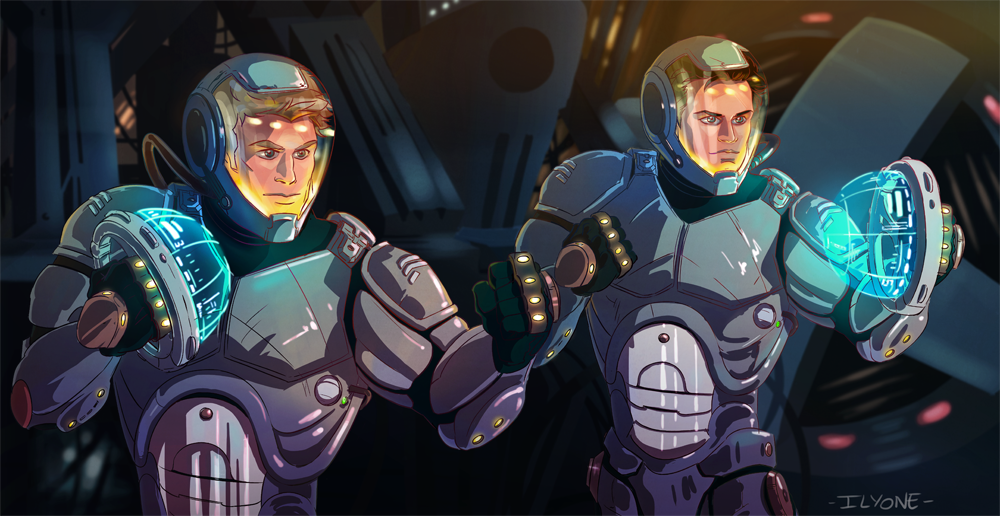
The Hamilton
We don’t settle for average; we aim to overperform and overdeliver. Just like Hamilton, we seize every opportunity to make a lasting impact, producing high-quality content that doesn’t just serve today’s needs but becomes a legacy for future education members. We set a bar that inspires others, putting in the energy and creativity needed to create work that resonates, endures, and serves as a standard for future generations. We lead by example, showing that dedication and performance are not just expectations—they’re commitments we live by.

In Closing
We’re not here to “teach” in the traditional sense. We’re here to empower, to ignite, to revolutionize. Education, when done right, is the strongest force for good, capable of saving minds, expanding horizons, and changing the world. This is our mission. And every student who sits in front of us is a chance to make that vision a reality.
Know that we don’t see ourselves as AI educators, nor HPC educators or programming educators. We’re educators, period. As a member of this branch, you have every right and opportunity to go above and beyond, to improve and grow in your skills, in your learning, in your personal life. As much as we transform the world to bring people closer to love and joy of learning, we very much hope that you transform to become the very best version of yourself.
Setup & Member Induction
In this chapter you'll setup some essential tools that you will be using throughout your training and time at Education.
Note that some sections are specific to particular teams and/or portfolios within MDN.
Only complete the section/s that is/are relevant to you.
Office 365
You will need to download Office 365, predominantly for PowerPoint and OneDrive.
Using your PC: Go to Microsoft Online

Enter your email address and authcate password. (You should have been automatically redirected to the Monash login page after visiting MS Online)

Now that you have successfully logged in, you will be redirected to the Microsoft Office 365 page.
Download to your personal device.

This is the official guide from Monash. (N.B. Up to date Nov 2024)
Induction Process
The following sub-sections detail the probation requirements for new members in their respective teams.
AI Outreach
- Read the entirety of the education training booklet
- Program a simple deep learning model & explain your program theoretically
- Program a parallel loop in C & explain your code theoretically
As educators of AI, we expect our members to be technically competent enough to be able to understand and apply the content they are teaching.
We ought to know what we’re talking about 🔥
By meeting the 3 requirements as outlined above, there will be virtually no question or task as an Education team member that you will be incapable of dealing with.
Don’t stress if you have no clue how to achieve those tasks 💯.
You will receive specialised trained by your manager/s to achieve these tasks, alongside accompanying resources.
You are also not expected to program completely by memory, but your explanations of concepts should be strong without reference to notes.
Induction Process: Law & Ethics Awareness and Outreach (AO) Member
Below outlines the steps new members must follow to become fully onboarded into the Awareness and Outreach (AO) subcommittee.
Phase 1: Welcome and Introduction
1. Add to AO Subcommittee Group Chat
- Invite the new member to the generic AO group chat.
- Encourage them to introduce themselves and seek their expression of interest for current AO projects.
- Based on their interests, invite them to relevant project-specific group chats.
2. Overview of Role and Expectations
- Provide a brief overview of the AO subcommittee’s goals: increasing awareness of ethical and legal issues in tech through outreach and creative engagement.
- Set clear expectations around contribution, communication, and accountability.
3. Required Reading: Ethical Principles of AI Use
New members must read and understand the following core principles. These readings will be provided by the Awareness and Outreach Manager:
- Accountability: Understanding who is responsible for the decisions made by AI systems.
- Bias: Identifying how bias can manifest in data and algorithms, and methods of mitigation.
- Privacy: Grasping the importance of protecting user data and complying with regulations like GDPR.
Phase 2: Training and Skills Assessment
1. Attend AO Standard Showcase Session
- Attend a 1-hour session run by senior AO members, featuring a walk-through of a prior workshop.
- This session will highlight the standards of quality expected in terms of content delivery, technical accuracy, design, and creativity.
- Introduction to essential tools commonly used in AO projects (e.g., PowerPoint, Canva, Google Drive, Notion).
2. Create an Engaging Slideshow Presentation
Following the workshop showcase, the recruit will be required to create and deliver a short presentation on a topic of their choice.
The Awareness and Outreach Manager will determine the allocated time for this practice presentation, depending on schedule and context.
The presentation must demonstrate one or more of the following:
- Effective use of morph transitions
- Use of 3D objects
- Hand-drawn or sketch elements
- Any other creative PowerPoint technique that enhances clarity and engagement
- MDN Branding Kit (Law & Ethics)
This will assess their creativity, tool proficiency, and ability to communicate effectively.
3. Engage with an Outreach Team Member
- Schedule a short conversation with a member of the Outreach team.
- Ask and answer questions to test understanding of technical concepts covered in AO workshops.
- This promotes cross-team collaboration and ensures the member can support or co-deliver content.
Phase 3: Project Assignment and Accountability
1. Assign to a Current AO Project
- Once foundational skills are demonstrated, assign the member to a live project.
- Define specific tasks and timelines (e.g., draft ethical case study slides, design a social media post, assist with event coordination).
2. Demonstrate Independent Working Capability
The member must be able to:
- Complete their assigned tasks within the allocated time frame (with a short grace period, if necessary).
- Communicate any delays or issues clearly and proactively.
- Work independently without placing unnecessary stress on other members.
Phase 4: Leadership and Ownership
1. Initiate and Lead a New Project
After proving reliability and competence, the member is expected to:
- Propose a new idea or project aligned with the goals of the AO subcommittee.
- Take ownership of its development and execution with mentorship from a senior member.
- Reflect on outcomes and document lessons learned to inform future work.
Meetings
Meetings are completely under the jurisdiction of managers with regard to their frequency, length, agenda etc.
You are expected to attend every meeting unless otherwise clarified.
If unable to attend a meeting, let your manager know ASAP.
All meeting minutes are kept on Notion.
Consult your portfolio manager for further clarification/questions.
Workshop Administration
All workshops follow a 3 step process:
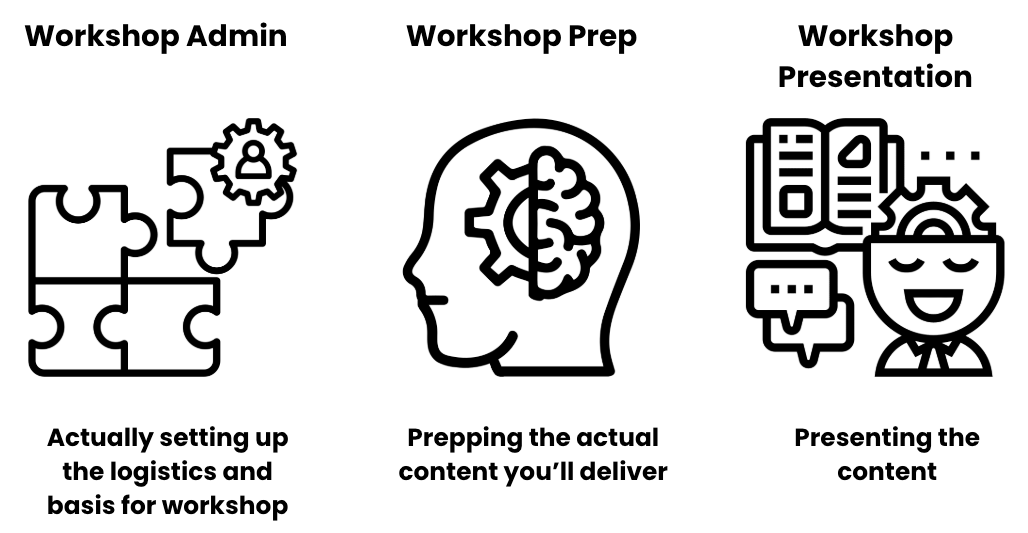
This chapter will cover the first portion- the workshop administration.
__1) When__
__2) Where__
__3) Marketing the event__
Timing Strategy
Timing is an often unconsidered component when planning workshops.
High School Workshops
Keep track of the term dates when planning and prospecting workshops at high schools.
As a general rule, try avoid workshops at the end of the year as motivation for students will likely be very low.
Furthermore, try avoid classes during times where students will likely be less attentive (final periods etc)
University Workshops
Within the context of university, when planning events:
- Motivation and attendance is highest in the first weeks of semester (W1-6)
- It drops off as the semester progresses
Using this knowledge is crucial.
In our experience, you should aim to position your key, headliner events (in our case: Intro to AI, Intro to HPC etc things of that nature) towards the first 3-4 weeks of semester.
This graph shows a generalised visual of how the interest looks across the sem.
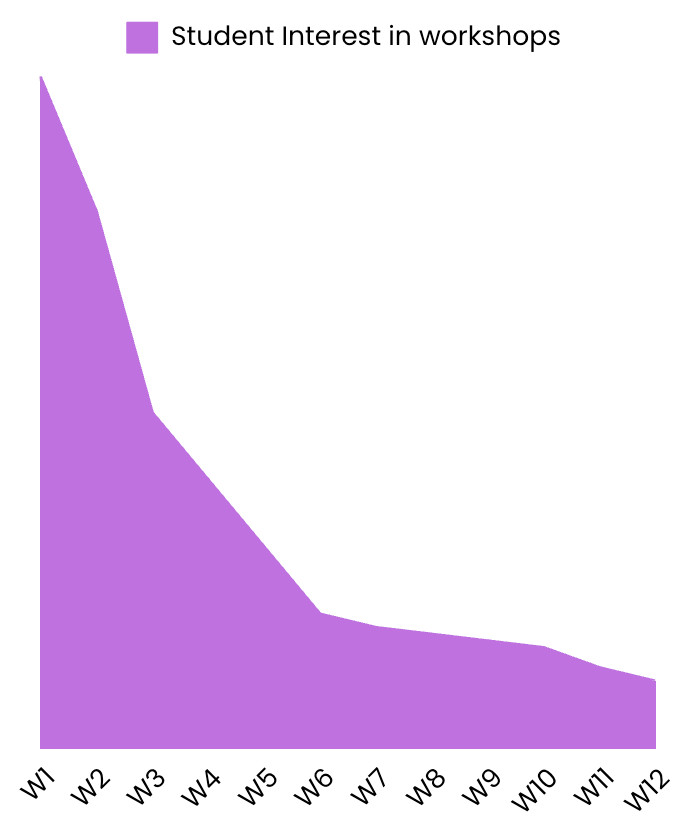
Week 1 in Sem 1 is also a fantastic time to have a lot of jaffies attend if you wish to target that audience.
The later weeks can be used for events where you wish to test ideas or train new members.
For example, you may hold a new Intro to OS workshop in week 11 to test out new content and see how you go presenting it. You may also choose to have newer education members present in later weeks to get practice without having the pressure to perform with the bigger audiences usually seen in the semester.
Location
Your room can have a major impact on the success of the workshop.
Generally, aim to have an open space where there are tables set up for people to collaborate in tables- this is particularly helpful for activities.
Lighting is also important since it can have a big impact on engagement (poor lighting → more drowsy etc.)
1. Open space
2. Tables that enable collaboration
3. Good lighting
Ensure it is an area with minimal distraction or potential for a disruption during your workshop.
Try to vet the room if possible before confirming/booking.
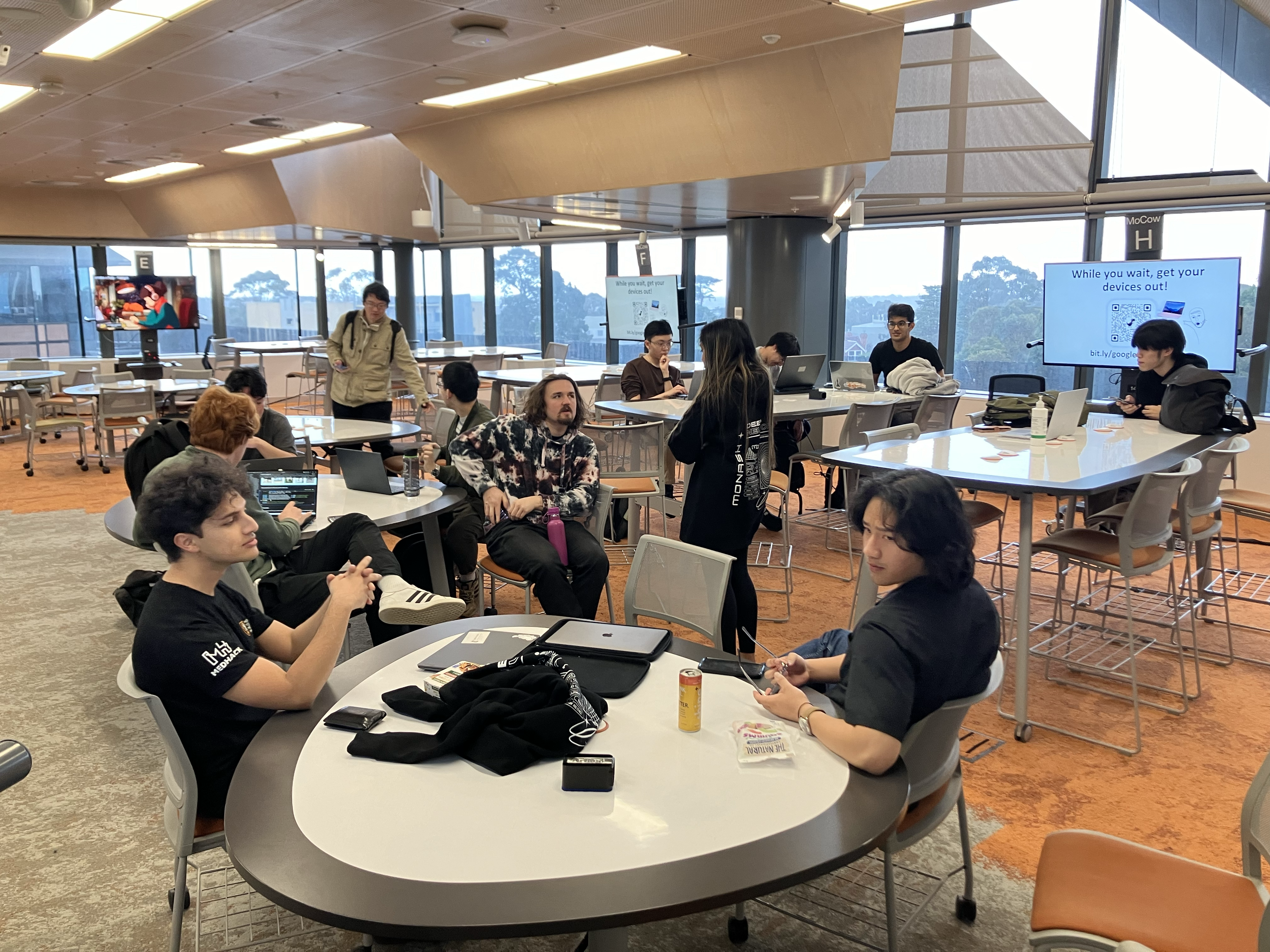
The open space allows presenters to walk around.
Seperated, circular tables allow for groups to form. This makes it easy to form teams for activities.
Lots of monitors- slides/content visible from anywhere
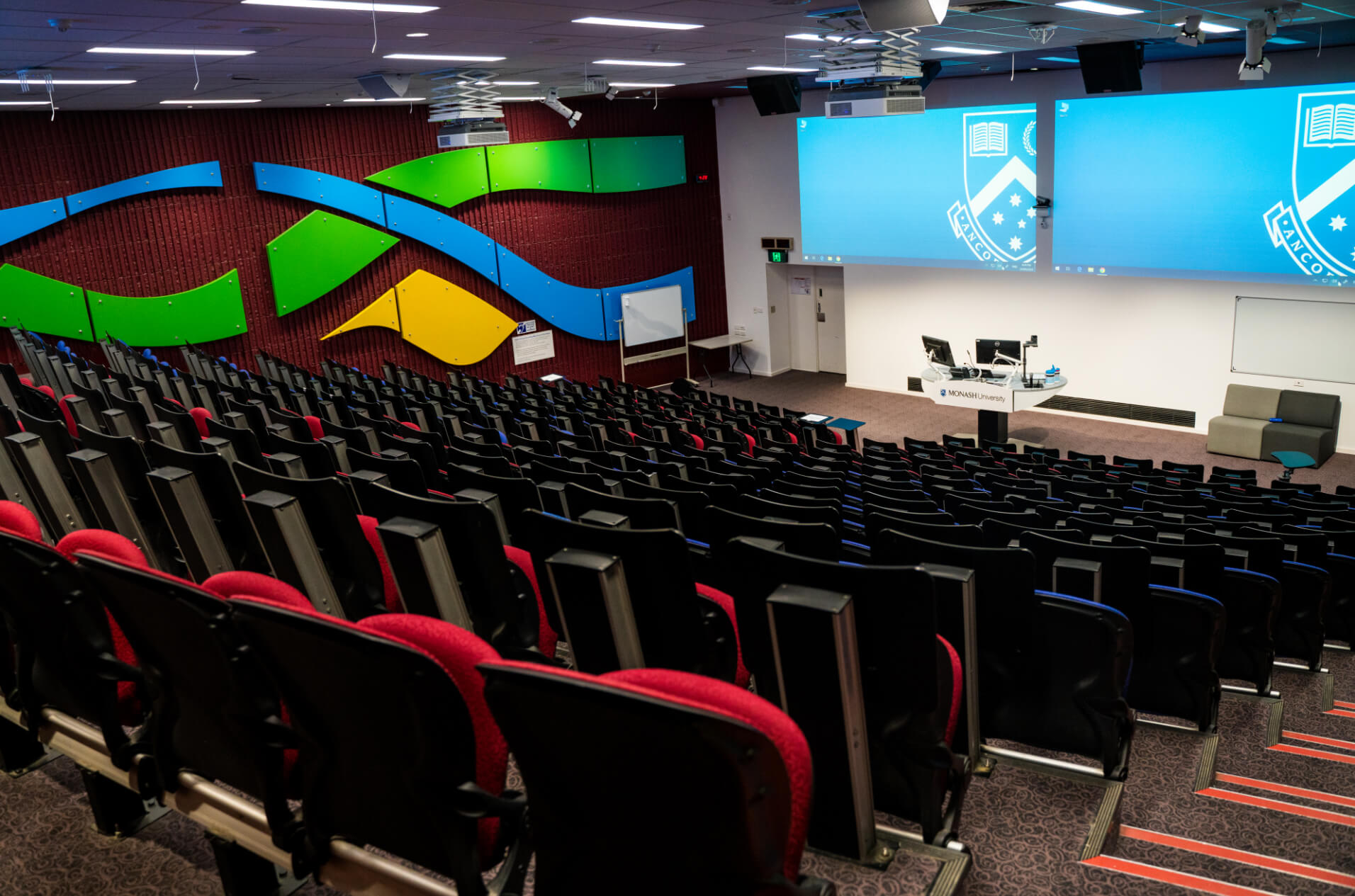
Space directs everyone's attention towards one direction.
Discourages collaboration since members are only able to easily discuss with people to their immediate left and right.
Due to seating design, people at the back see slides less clearly than those towards the front.
Note: This design __may__ be ideal depending on the circumstances of your presentation. It ultimately depends on your goals.
Marketing
You must decide how you wish to market the event once it's been confirmed.
High School Workshops
Generally you will be presenting to a class that is 'forced' to be present in a classroom.
If however, it has voluntary attendance, ensure you get the teacher contact to publish the event on relevant messaging platforms to students at several intervals leading up to the event.
University Workshops
MDN has a dedicated marketing team to manage marketing for events.
Reach out to them to set up posts etc.
How to market the event is beyond the scope of this booklet.
Business/Events
You must decide how you wish to engage the Business team once event planning begins.
Venue Booking
If you need a specific space on campus, such as a seminar room or lecture theatre, the Business can help with identifying and booking an appropriate venue. Provide them with the event date, time, expected number of attendees, and any technical requirements.
Catering and Refreshments
For larger or more formal events (e.g., panel discussions or industry networking), you may want to provide catering. Business can assist with:
- Sourcing affordable catering options
- Organising dietary requirements
- Managing delivery or pick-up logistics on the day
Budget and Invoicing
If you require funding support or need to cover expenses for things like printing, catering, or decorations, Business can guide you through the process of submitting a budget request and handling reimbursements or payments.
Connecting With Schools
💫 What’s This All About?
Let’s be real – AI is everywhere. From self-driving cars to TikTok’s scarily accurate ‘For You’ page, artificial intelligence is shaping the world faster than most people can keep up with.
That’s where we come in.
MDN isn’t just about cool AI and HPC projects – we’re about bringing AI education to the next generation. Whether it’s coding hands-on projects or diving deep into AI ethics, our goal is to make sure students don’t just learn what AI is, but why it matters.
This playbook is your ultimate how-to guide for reaching out to schools, locking in workshops, and making sure students walk away engaged, inspired, and maybe even wondering if their toaster is collecting personal data... 😅
🛠️ What This Guide Covers
🔷 How to research and choose schools to contact
🔷 How to email and call schools effectively
🔷 How to follow up and track outreach efforts
🔷 Best practices for securing and running workshops
AI is shaping the future, and we’re here to make sure students are ready for it 🚀🔥.
How to Research & Choose Schools
Let’s be real – getting a school to say yes is hard. Not gonna lie, most of the time, you'll be hitting up schools and getting nothing but radio silence. Emails go unread, phone calls get transferred around, and sometimes, you’ll never hear back.
But that’s the game. Schools are busy, and MDN Education isn’t always their top priority.
That doesn’t mean you stop trying. It just means you’ve gotta be smart about how you reach out.
🎯 Start with Your Own Connections
Before you start cold emailing random schools, use what you’ve got.
Personal connections will always be the easiest way to get a foot in the door.
✅ Your Old High School – Teachers love seeing their ex-students thriving.
Hit up a teacher who knew you, or the school’s STEM/IT department. Even if you weren’t a STEM kid, any teacher who had an impact on you is worth reaching out to.
✅ Friends & Family – Does your sibling’s school have an IT program? No siblings? No worries. Maybe your cousin’s school has a robotics club, or your friend’s little sibling’s school has a Legal Studies class that would be perfect for an AI ethics workshop? Don’t be afraid to leverage your network.
✅ Past MDN Workshop Schools – If we’ve run a workshop at a school before, chances are, they’ll be open to another one. Check the Notion page to see where we’ve already been and follow up with past contacts.

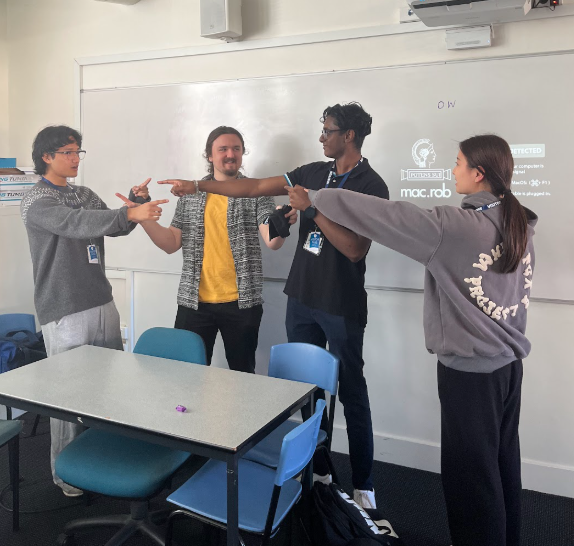
🔍 How to Pick the Right Schools
If you’ve exhausted your connections, it’s time to do some research.
The goal is to find schools where our workshops will make an impact – not just cold email every school in Australia.
✅ Check School Type & Relevance – Is it public or private? Primary or secondary? Do they already have AI, tech, or ethics programs that align with what we offer/what we can offer?
✅ Look for Existing STEM/AI Initiatives – If they have a robotics club, coding program, or even ethics classes, they’re more likely to say yes because our content fits naturally into what they already do.
✅ Find the Right Contact Person – Generic school emails (like info@school.com) are usually black holes where emails go to die.
Instead, try to find a specific person who would care about AI education. Some people that we have found are best to contact are:
- STEM/IT Teachers – The easiest in for AI-focused workshops.
- Ethics/Legal Studies Teachers – If we’re pitching AI ethics and law workshops.
- Extracurricular Coordinators – They handle guest speakers & programs.
- Careers/Pathways Advisors – If the school focuses on AI/tech careers, they might be keen.
✅ Use the MDN School Research Template – Before reaching out, make sure your team has a Notion page to track school outreach. This prevents multiple people from contacting the same school, which can come off as unprofessional and disorganized. Keep it clean, keep it coordinated.
How to Email Schools Effectively
Emailing schools isn’t just about firing off a generic message and hoping for the best.
Teachers and school staff get flooded with emails daily, so the key is to stand out while keeping it professional and concise.
🔥 Best Practices for Emailing Schools:
✅ Start with something attention–grabbing – The first thing they read should make them want to keep reading. This could be:
- A GIF or sneak peek of our slides to instantly catch their eye
- A direct connection to their school’s curriculum
("We noticed your school has a strong IT/Legal Studies program—this would be a great fit.")
✅ Keep it concise and direct – Teachers are busy. A long-winded, boring email will get ignored. Get to the point quickly.
✅ Make it easy for them – Schools won’t commit if they feel like it’s a hassle. Offer flexible dates, emphasize that the workshop is free, and let them know they can choose between online or in-person.
✅ Include visuals when possible – Attaching a workshop poster or a sample slide makes it instantly more engaging than just a wall of text.
✅ Reassure them – show we’re legit – Schools want to know they’re not wasting time. Mention our past successful workshops and the schools we’ve already worked with to build trust.
✅ Offer a meeting – If they’re interested but not fully convinced, suggest a quick Zoom or in-person chat to go over the details and answer any questions.
✅ Follow up, always – Most schools won’t respond to the first email. That doesn’t mean they’re not interested—they’re just busy. Following up politely but persistently increases your chances of getting a reply.
Refer to the how to email schools template here.
How to Calls Schools Effectively
Calling a school can feel intimidating, but it’s the fastest way to get a direct answer – whether it’s a yes, no, or “Send us an email instead.”
Unlike emails, which can sit unread for days, a call gets immediate attention and shows initiative.
The key? Be confident, clear, and engaging.
You’re not a telemarketer or someone trying to sell a scam – you're offering something valuable, exciting, and free.
Schools will appreciate the opportunity if you present it well.
Tips to Secure the Dub:
✅ Start strong – Hook them with something interesting instead of a generic “Hi, I’m calling about AI workshops.”
✅ Get to the point quickly – Teachers and staff are busy; they don’t need a long intro.
✅ Ask for the right person – Receptionists won’t make decisions, so always ask who handles guest workshops or AI/STEM programs.
✅ Be flexible & easy to work with – Let them know we offer both in-person and online options to fit their schedule.
✅ Expect redirections – You’ll often be transferred, asked to email, or told they’ll get back to you – stay persistent and don’t give up easily.
✅ Follow up immediately – If they ask for an email, send it right after the call while they still remember you. Don’t delay it!
Refer to the how to call schools template here.
Best Follow Up Practices
Reaching out is just the first step – following up is where the real progress happens.
Schools are busy, and emails often get buried under a mountain of admin work. A lack of response doesn’t mean they’re not interested – it just means we need to remind them (politely but persistently).
At the same time, tracking our outreach efforts is crucial.
If we’re not organized, we could end up emailing the same school multiple times or missing out on opportunities simply because no one followed up.
To keep everything organised and professional, we track all outreach efforts in a Notion page – so ensure that you have created one with your team.
Tips to Stay on Top:
✅ Always follow up – If you don’t get a response, don’t assume it’s a no.
Schools take time to process external opportunities, and a quick reminder email can make all the difference.
✅ Wait 3–5 days after the initial email – If they haven’t replied, send a friendly nudge.
(Example: “Just following up on my last email to see if this would be of interest to your students.”)
✅ After one week, send a second follow-up – If there’s still no response, send a slightly more direct follow-up.
Keep it short, polite, and make it easy for them to respond.
✅ If there’s still no response after two weeks, move on – Some schools just won’t be interested, and that’s okay.
Mark them as unresponsive and focus on other leads.
✅ Use multiple contact methods – If you originally emailed, try a phone call for the follow-up.
Some staff members respond better to calls than emails.
✅ Keep it casual, not pushy – We’re not selling a product—we’re offering a valuable opportunity for students.
Like you guys know how good our workshops are. The tone should always be polite, professional, and positive.
Securing the Workshop
Now that you have secured the workshop we have to make sure that things run smoothly.
Make Sure To:
✅ Confirm the details ASAP – Once a school shows interest, lock in the key details quickly to avoid unnecessary back-and-forth.
🧾 Confirm:
- Date & Time – Make sure it doesn’t clash with exams or major school events.
- Duration – Some schools might only allow a short session, so be flexible with time.
- Year Level & Subject – Tailor the workshop depth to the students’ background knowledge.
- In-Person or Online? – If in-person, confirm logistics. If online, ensure a stable platform (Zoom, Teams, etc.).
- Number of Students? – Helps us plan interaction levels and workshop activities.
✅ Set expectations early – Teachers want to know exactly what their students will get from this. Give them a short breakdown of what the workshop will cover and how it aligns with their curriculum.
✅ Send a confirmation email – Once details are agreed upon, send a follow-up email with:
- A short workshop summary (so teachers can brief students).
- Any resources students need beforehand (if applicable).
- A point of contact for last-minute questions.
✅ Check school rules & tech setup – Some schools restrict external software or have firewall issues that could block demos. This has happened in the past a few times with our workshops! Clarify tech requirements in advance to avoid last-minute disasters.
✅ Arrive early (or log in early for online workshops) – Give yourself time to set up, test tech, and settle in. Nothing kills energy like rushing through setup.
Workshop preparation
Prior preparation prevents poor performance
When 99% of people approach presenting a workshop, the first thing they do in preparation is create a rough outline of what they'd like to discuss with no real framework in mind.
Whilst this is ok, we can do wayyyyyy better.
In our experience presenting at MDN, we've fleshed out a methodology to preparing our workshops to ensure they're cohesive and most importantly, engaging.
This probably the most important chapter in this book as it forms the foundation for what you're actually presenting.
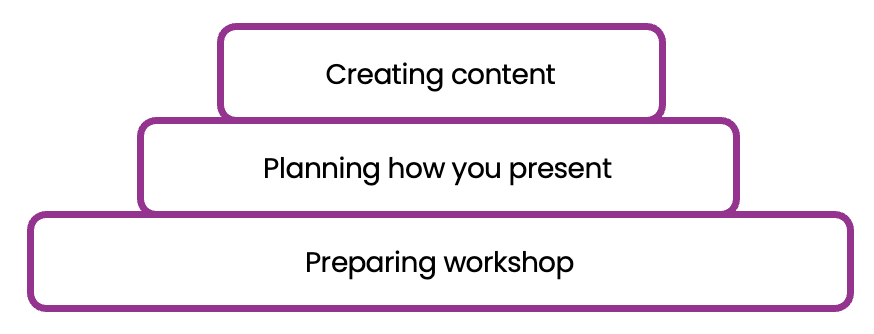
With a bad foundation, no matter how cool your PowerPoint looks, literally no one will care.
These frameworks have yielded us great success, and we hope it does the same for you ❤️.
Much of the content in this workshop is adapted from:
Audience is everything.
For every workshop you present with us, there will be three types of members in your audience:
For each of these archetypes, here are our goals:
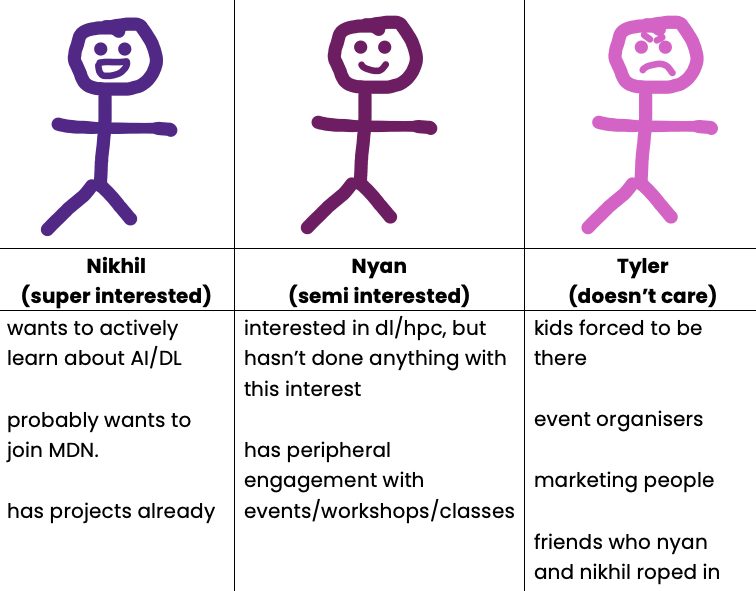
Different workshops will have different ratios of Nyans, Nikhils and Tylers:
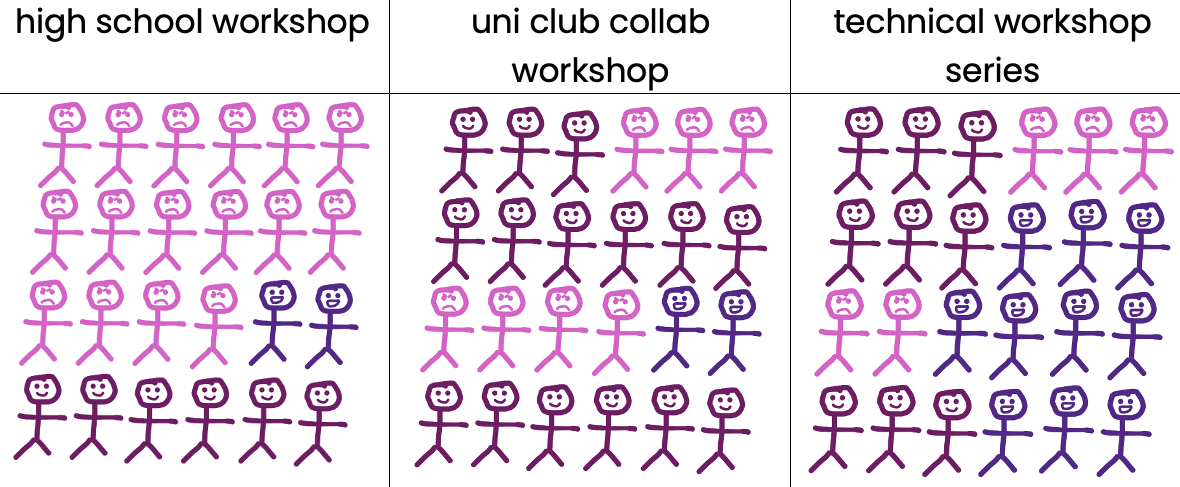
You’ll have to tailor your workshops to appeal to the dominant archetype/s you presume will be there on the day.
If you have a lot of Nikhils, you want to go technically deeper, making sure you stimulate them intellectually.
Conversely, if you have a classroom of Tylers, your pure focus should be keeping them engaged.
The degree to which they’re engaged depends entirely on your judgement of which archetype dominates your audience as they should guide the scope and actual content, which will be covered later.
Most presenters focus on the specific workshop stuff. (oHHhhHhh My god WHaT Font ShOuld i uSE FOr my 5 sliDe powERPoInT guYs 🤓 )
You should spend some time thinking about the audience.
The spread of archetypes determines the success of whatever you present/create.
The Speaker
Your audience is there for YOU, not the content.
This seems false, especially for Tylers and Nyans, but think about it.
Information is free and abundant. It takes them 0.00003 seconds to get thousands of resources on AI and HPC.
They are at this workshop, because the hope is that you, yes YOU, are able to organise this information in a way that’s meaningful to them.
This leads to an interesting natural logical consequence…
No one else should be able to present the workshop like you do.
I don’t mean that in a corny, you’re a special snowflake way.
I mean that you should organise the information in a way that is relevant to you as a person. References, memes, stories, why YOU care.
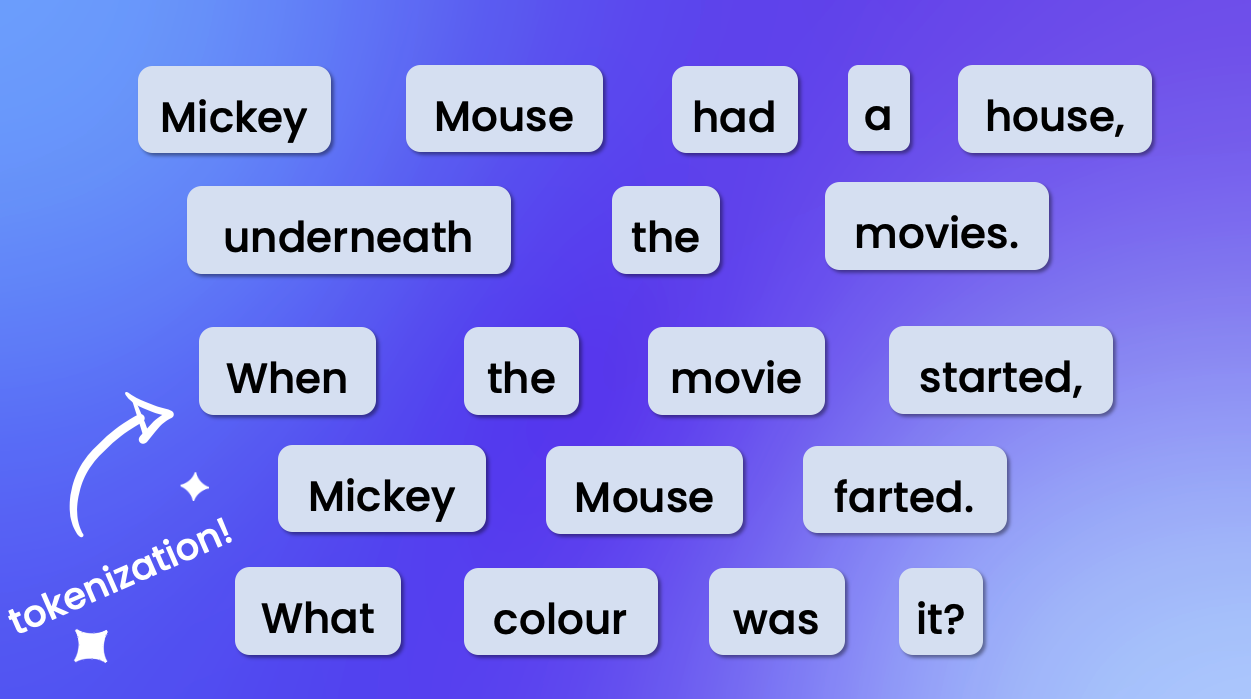
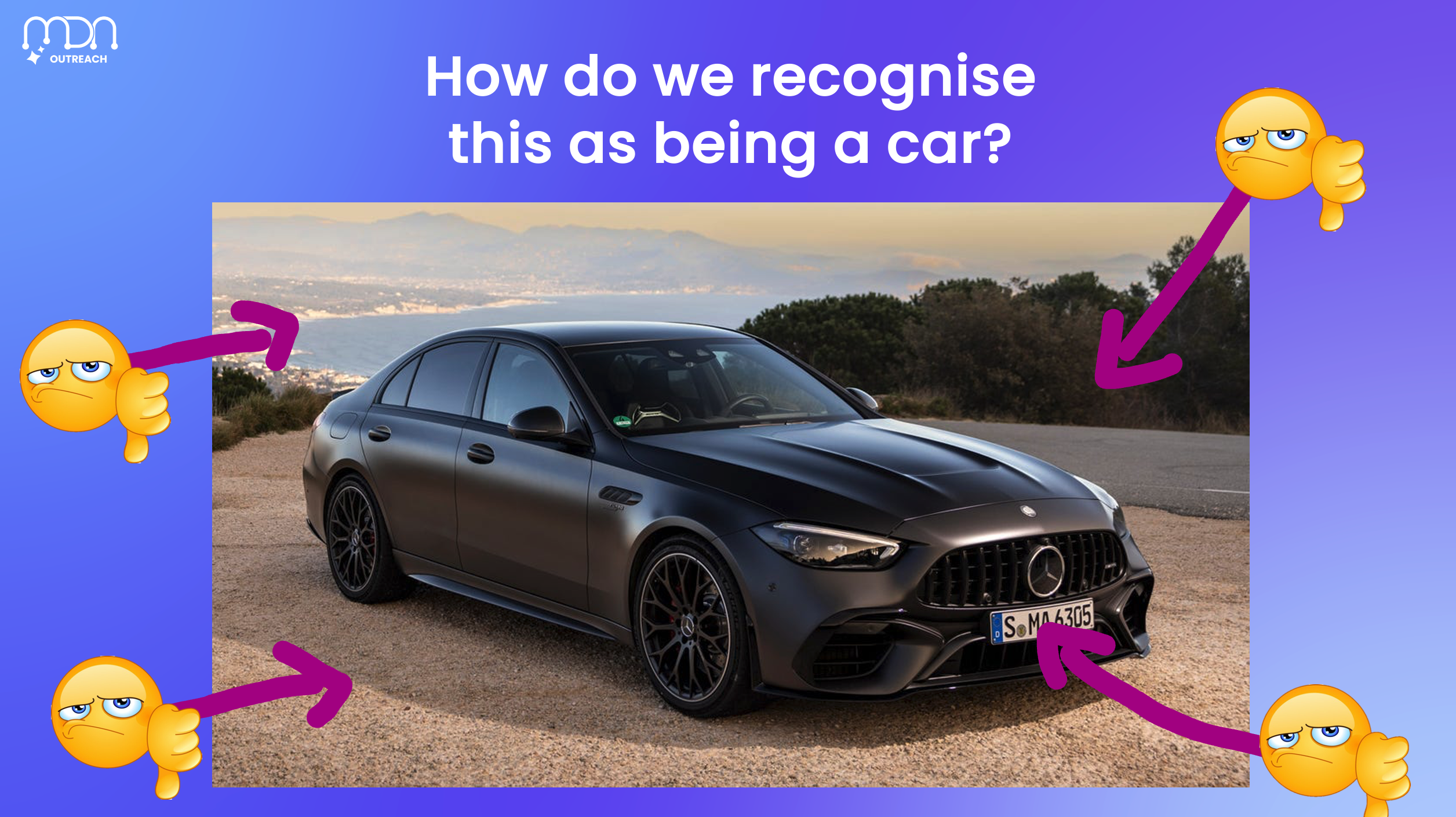
So before you approach any workshop, consider how you are going to use your knowledge and experiences to make it unique. Things to consider:
- Your experiences (internships, classes etc)
- Your projects
- Hobbies
- References/memes etc
The Journey
Don’t inform, take them on a journey
This is likely the biggest paradigm shift you will encounter in the MDN Education team.
We don’t believe our goal is to inform.
We believe our goal is to inspire (i.e. arouse interest).
This was covered in depth in our philosophy section, but we believe that after our workshop/s, attendees should feel inspired about AI/HPC.
Consequently, our goal is behaviour change, not technically education (as its defined commonly).
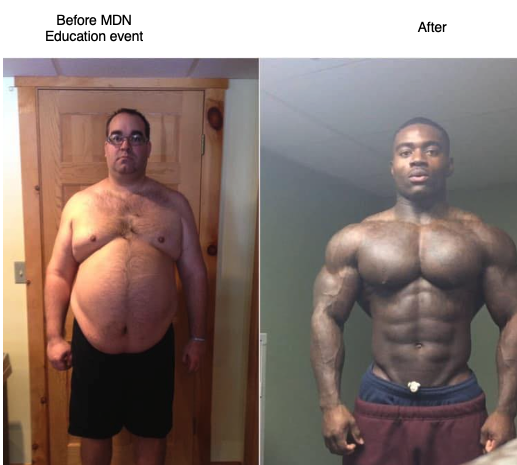
This is entirely about creating an emotional experience.
To create this emotional experience, we must take them on a journey.
To plan this journey, we must consider what the audience was like prior to the event, and what we would like them to be like after the event.
More specifically, we want to narrow our understanding of their:
- Knowledge
- Beliefs
- Actions
We want to then plan our workshop/s such that after, they have a different set of knowledge, beliefs and actions.
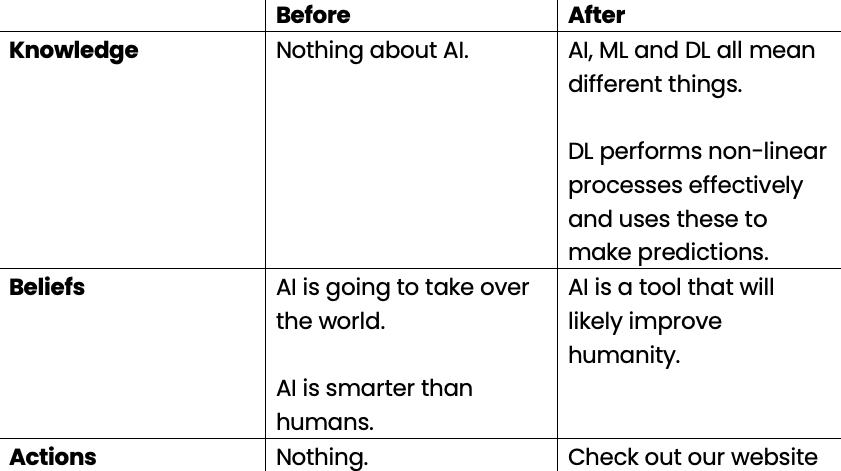
The actions don’t need to be super sophisticated.
So, we’ve identified where they are before the workshop and where we’d like them to be. It is from here that we flesh out the content for the workshop.
This content has the singular goal of taking our audience on a journey to achieve the desired ‘after’ state.
Journey Framework
Putting the theory in practice from the previous sections, we now have a structured framework we can use when planning our workshops:
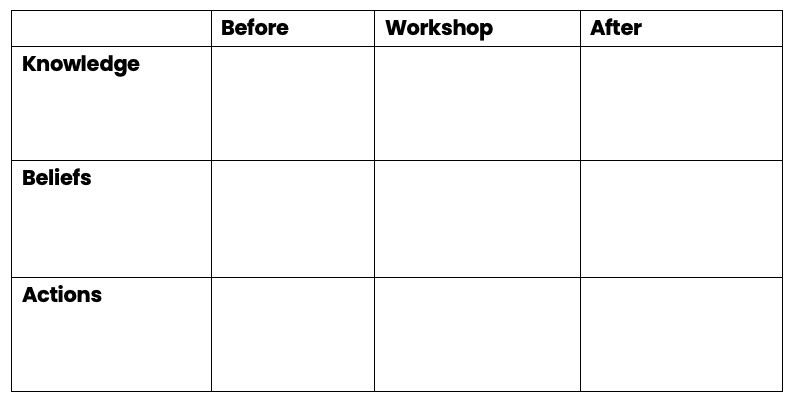
Use this when planning for workshops.
It follows a simple input, processes, output structure.
Here is an example of one filled out:
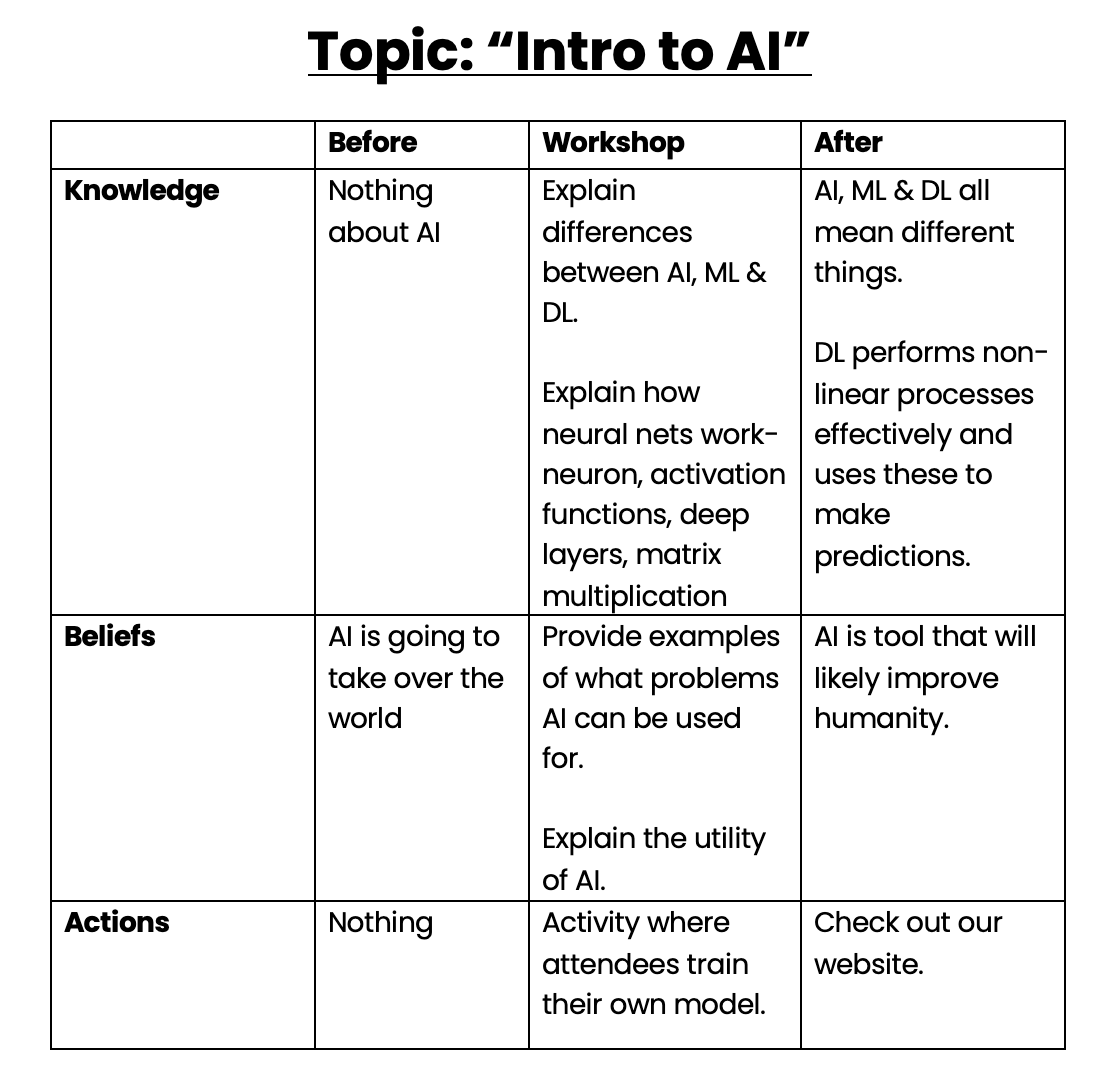
FERAL Framework
Workshops at MDN aren’t just “sit-and-listen” sessions – we make them interactive, engaging, and actually worth attending. That’s where FERAL comes in.
No, it’s not about going absolutely wild (although, sometimes that happens hehe 😉).
It’s about creating workshops that:
✅ Flow seamlessly
✅ Engagement with participants
✅ Relatablity to real-life concepts
✅ Aesthetically beautiful
✅ Legacy create
And why do we do it? Because education is more than just delivering information – it’s about making an impact.
As your Education Leads, here’s what drives us:

💬 "One of the major highlights of teaching is witnessing that 'Aha!' moment on a student’s face. It’s absolutely priceless to see someone transition from confusion to understanding – from ‘what on earth is this?’ to ‘I actually get it now.’ That’s exactly why I teach, and I know it resonates with many of us in this profession."
– Shajana (Sarge), Education Co-Lead

💬 "I believe deep learning will be a cornerstone technology in solving some of our biggest problems, so the opportunity to turn something which is (seemingly) complicated into something tangible that students can understand is what makes MDN Education so amazing."
– Jeevan, Education Co-Lead
This is why FERAL exists – it’s our way of ensuring that every MDN workshop is an experience, not just a lecture.
In our personal experience of curating workshops at MDN, we have distilled these 5 key criteria points that outline what makes our workshops so great 🔥.
🚀 Let’s break it down. 👇
Flow
Make it feel like a story, not a lecture!
Ever read a book that just flows so well you can’t put it down?
Your workshop should feel like that – but with less reading and more doing.
💡 What this means:
-
The structure should make logical sense – no jumping from “What is AI?” straight to “Let’s build a GPT-5 Ultra Pro Max Clone in Verilog” or “Time to code a robotic doctor to perform surgery on my papercut.”
Let’s take it one step at a time, yeah? -
It should feel smooth, like a well-edited movie. Transitions between topics should be natural, not like switching channels on a bad TV signal.
-
Use checkpoints to keep people on track (polls, questions, mini demos).
🔍 Ask yourself:
✅ Does one section flow smoothly into the next like a narrative?
✅ Would someone with zero context be able to follow along?
✅ Are there natural pauses to check for understanding?
✅ Is there enough discussion with the audience?
🎯 Example:
Instead of dumping all the theory at the start and hoping attendees stay awake, start with something engaging – a quick AI demo, a meme, or even a question like “What’s the dumbest thing an AI has ever said?”
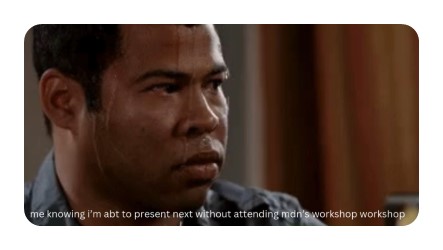
✍️ Narrative Structure in Practice
Each section of the workshop should lead smoothly into the next – like a good story.
Don’t treat it as separate pieces you just glue together. Think of it as a narrative arc – a journey you guide your audience through.
🧾 Example of planning the flow of workshop with preliminary schematics
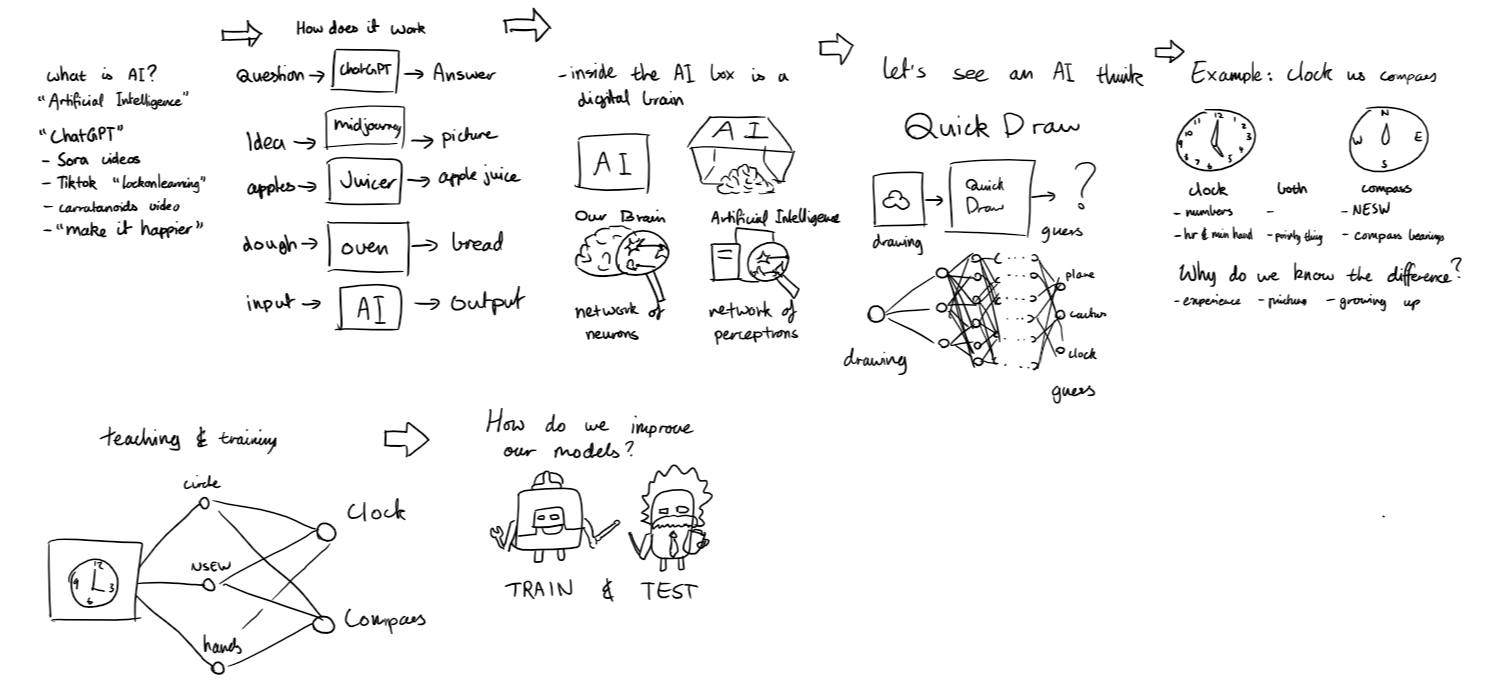
📋 Real example of workshop structure for high school students

Engagement
Let’s be real – if people just wanted to listen, they’d speed-run a YouTube lecture at 2x speed.
A great workshop isn’t a monologue; it’s an experience. The more hands–on, the better!
💡 What this means:
-
At least a third of the workshop should be hands-on. 🛠️
-
Activities should be varied – don’t just rely on Kahoots (even though we love them).
Think scavenger hunts, live coding, group challenges, games and more to keep things fresh and engaging. -
If participants walk away feeling like they just sat through a lecture, we’ve missed the mark.
A great workshop should feel interactive, not like a YouTube tutorial on autoplay.
🔍 Ask yourself:
✅ Are attendees physically or mentally participating?
✅ Can you turn any passive section into an active one?
✅ Does the speaker interact with at least one audience member every couple minutes?
🎯 Example:
🚫 Passive: You explain how AI can generate pickup lines while everyone just listens.
(Boring. Feels like a TED Talk no one signed up for.)
✅ Active: You challenge students to battle ChatGPT in a cringy pickup line contest – who can make the best (or worst) AI-generated pickup line?
(Now, they’re engaged, experimenting, and maybe slightly regretting their life choices. Perfect.)
🧪 Real-world application
As a rule of thumb:
At least 1/3 of the entire workshop should be purely practical activities
There are obviously exceptions, but generally, a 1:2 ratio between listening and action should occur.
We want participants to be actively engaged during these activities.
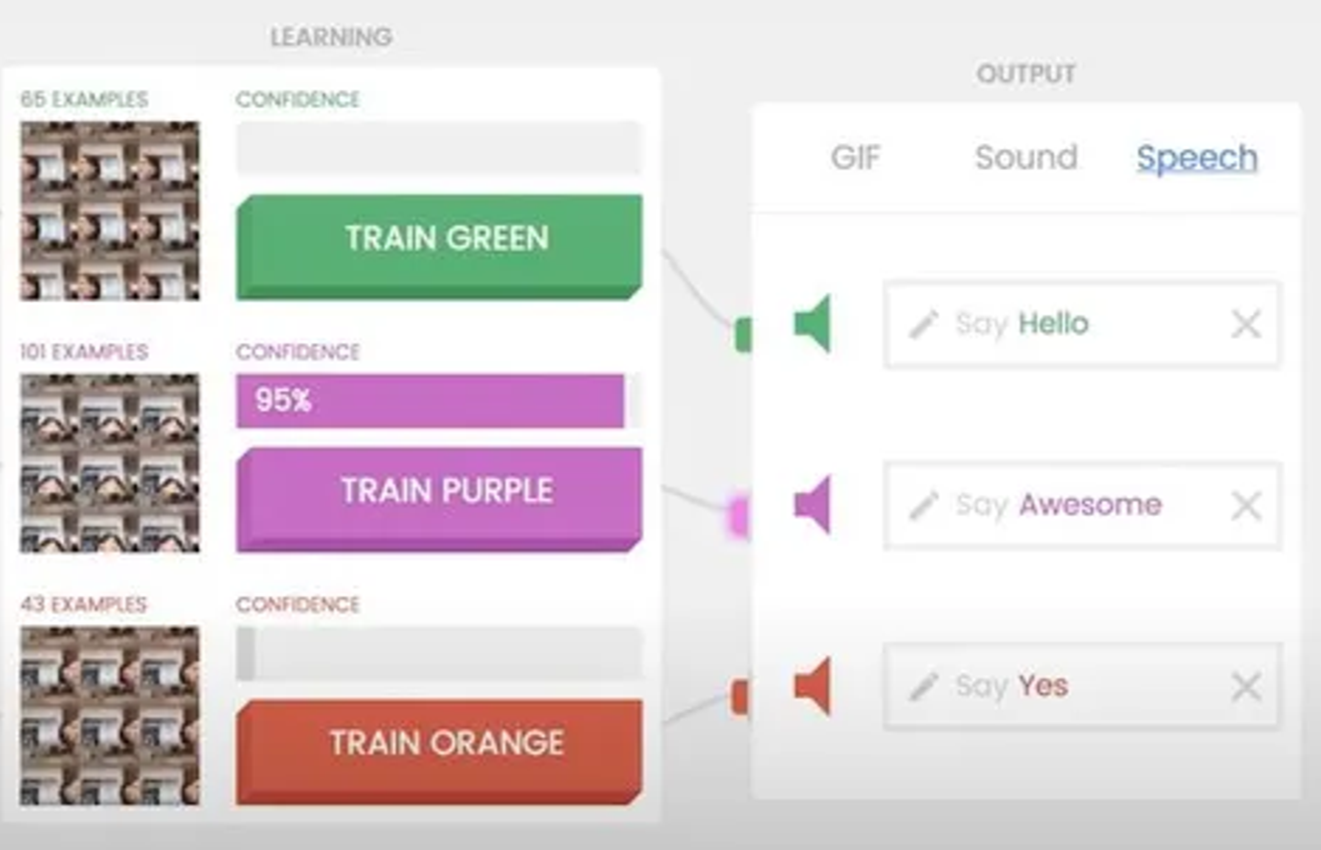
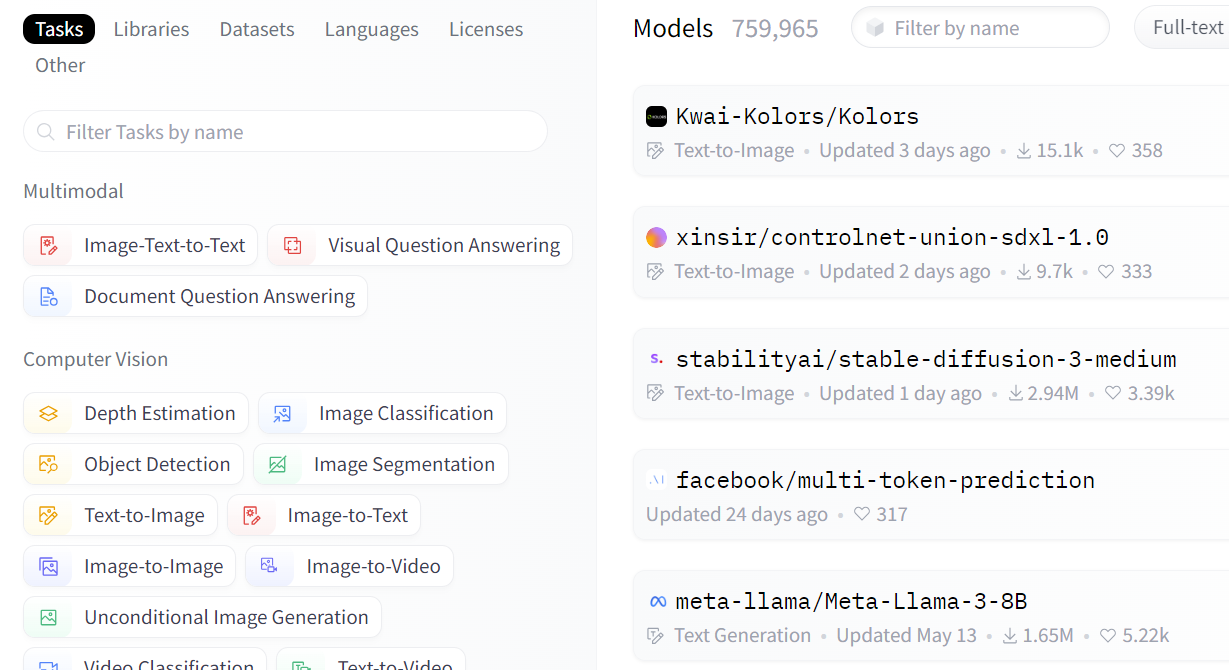
Relatability
People remember funny, relevant, or relatable things way more than abstract definitions.
Want someone to understand anything you're teaching?
Relate it to them. It’s that simple.
💡 What this means:
-
Every topic should connect to something real – a meme, a pop culture reference, or a trending app.
-
Use analogies to explain complex ideas (e.g., “Neural networks are like making pancakes – lots of trial and error before you get it right”).
-
Make it personal – ask people about their experiences and how the topic relates to their lives.
🔍 Ask yourself:
✅ Can you replace a boring example with something cooler?
✅ Is the explanation fun without being dumbed down?
✅ Are you using analogies to make complex ideas easier to grasp?
🎯 Example:
Instead of defining recommendation algorithms, ask:
“What’s the weirdest thing YouTube has ever recommended to you?”
Then, explain how AI tracks user behaviour to push content.
For example, if you watch one Gordon Ramsay video, YouTube thinks you thrive on watching him lose his mind over raw chicken at 2 AM, as if your life depends on it. 😭😂🍗

🧪 Real-world examples
No exceptions – even the “technical” stuff should feel personal.
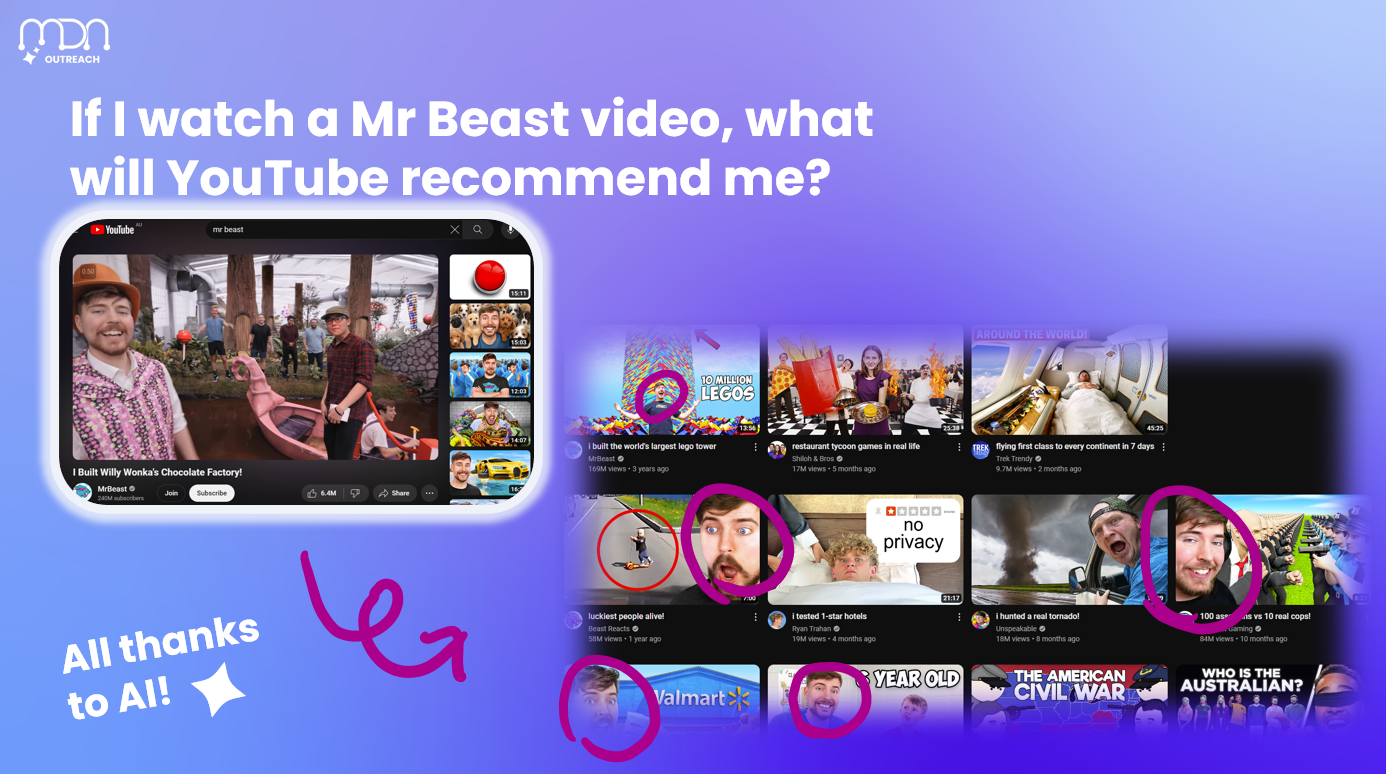
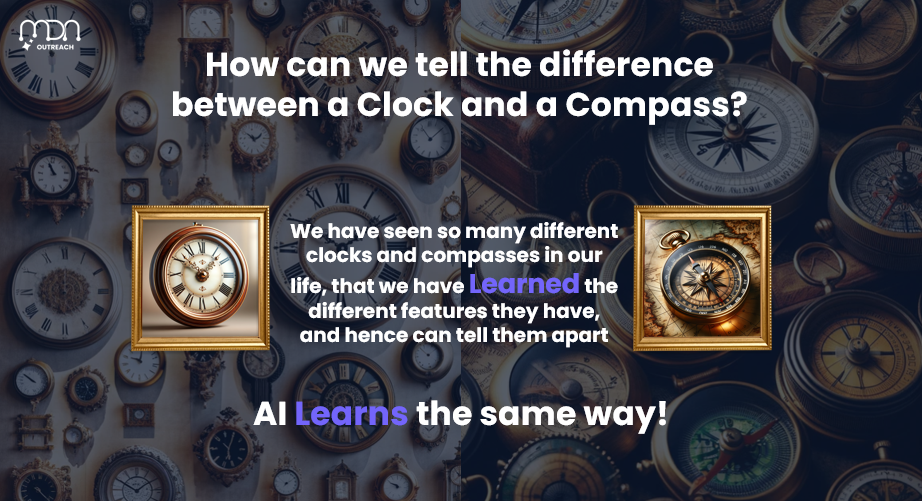
Aesthetic
We're not saying your slides should look like a Pixar movie... actually, why not?
Imagine smooth animations, vibrant colours, and a design so crisp it deserves an Oscar.
That’s the goal – and don’t worry, you’ll master the art of slide-making with help from the team.
At the very least, your slides should be clean, professional, and visually engaging –
because let’s be real, no one wants to sit through slides that look like they were thrown together in MS Paint at 3 AM.
Good design keeps people engaged and makes information easier to digest.
💡 What this means:
-
Follow the MDN branding kit – we have it for a reason.
-
Keep slides minimalist and visually appealing – the less text the better.
-
Use consistent fonts, colours, and icons – check out our Workshop Pitch Deck
for an idea of how we do it here at Education.
🔍 Ask yourself:
✅ Are my slides easy to read and visually engaging – have I included enough memes?
✅ Do they match the MDN branding kit?
✅ Would I enjoy looking at these for the duration of the presentation?
🎯 Example:
Instead of a boring title slide, make it pop with animations, bold colours, and large, readable fonts.
And please – for the love of good design – no pixelated images…
unless it’s for meme purposes 😏😈
🧪 Real-world visual examples

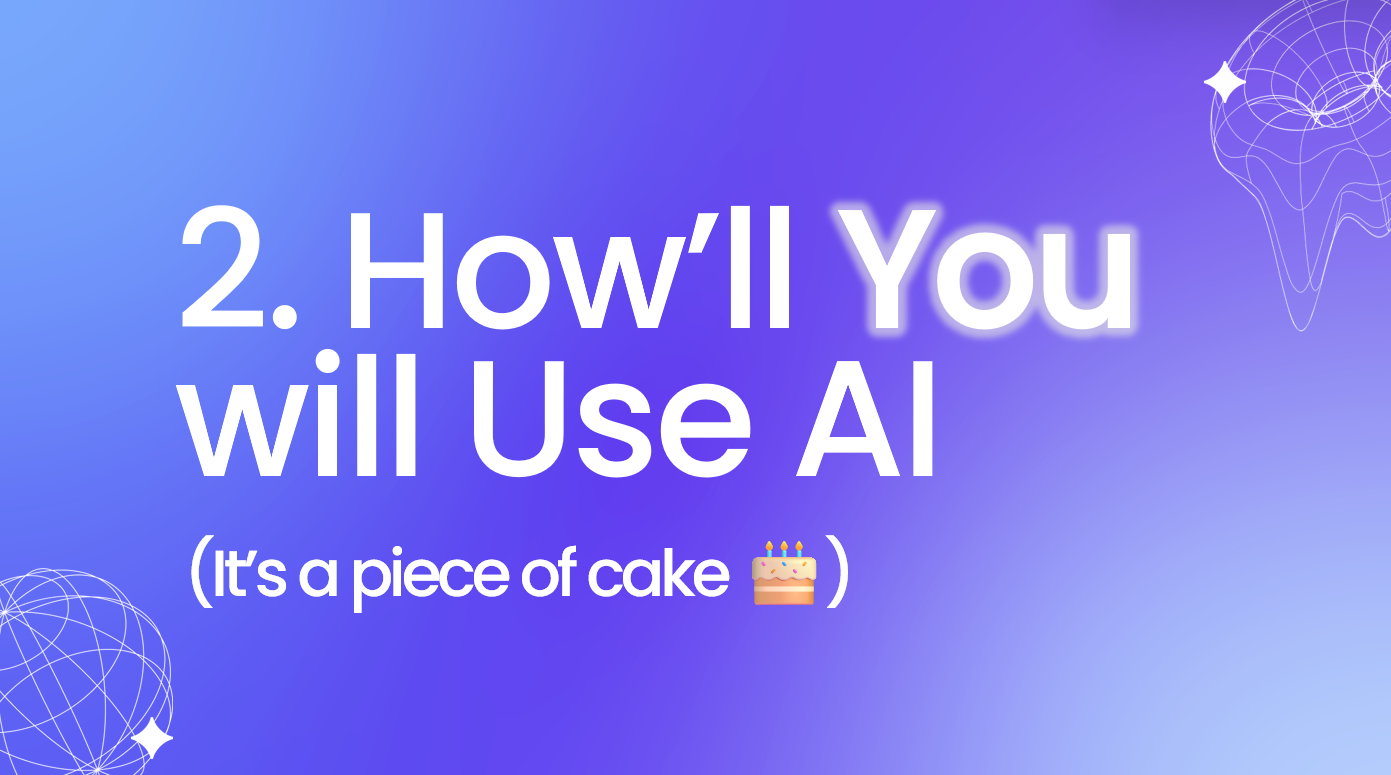
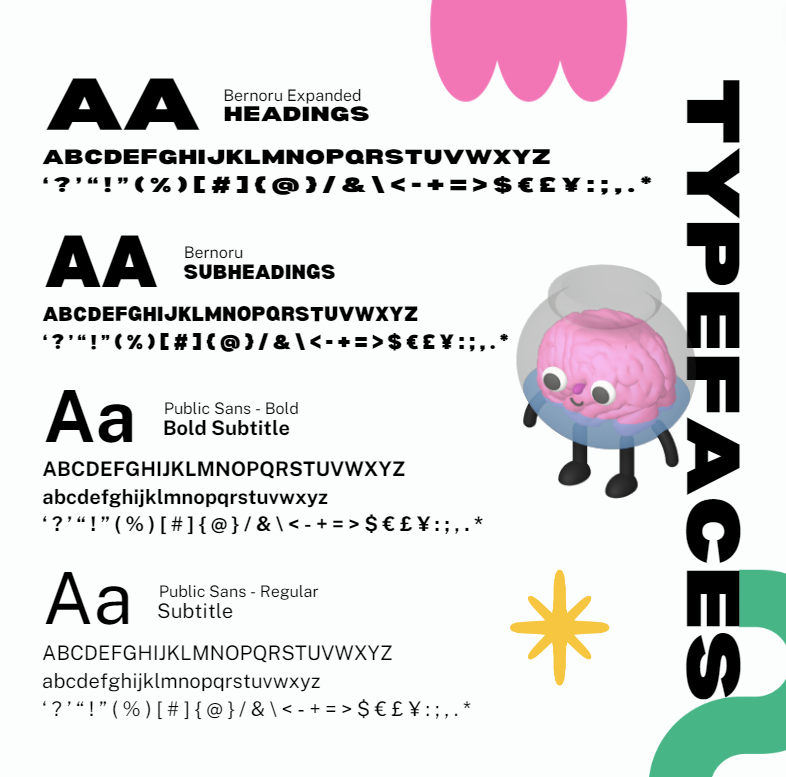

Legacy
A great workshop doesn’t end when the session does – it sticks with people.
Legacy is all about ensuring that attendees walk away remembering what they’ve learned, feeling inspired, and maybe even sharing it with someone else.
If your workshop was good, you SHOULD have people you've never met before staying back afterwards chatting to you. That's the kind of lasting impression we aim for.
💡 What this means:
-
Every workshop should give attendees something valuable to take away – whether it’s a project, a new skill, a challenge to complete, or even a quick fact they’ll bring up over dinner.
-
The final section should reinforce key takeaways – leave them with something sticky and impactful.
-
And let’s not forget: feedback is a must. We’re always looking to improve, and post-workshop insights are pure gold.
🔍 Ask yourself:
✅ Will attendees remember what they learned in a week? A month?
✅ Is there a way to follow up (resources, discussion groups, future events)?
✅ Is there a chance for feedback and reflection before the workshop ends?
🎯 Example:
Instead of ending with a dry “Any questions?”, go out on a high note:
✅ A Kahoot or interactive quiz
✅ A mini challenge or game
✅ A funny but memorable sign-off
✅ Or something personal and heartfelt – leave them smiling or thinking

Other Key Factors
We stuck with FERAL because, let’s be honest, it sounds cool. 😎 But there are a few other things that can make or break a workshop – so keep these in mind too:
🛠️ Practicality (Make it useful!)
✅ Are attendees walking away with real-world skills or knowledge they can use?
✅ Can they apply what they've learned outside of this session?
🕒 Planning & Timing (Respect the clock!)
✅ Is the workshop well-paced (not a rushed info dump, but also not dragging)?
✅ Is there buffer time for questions, discussions, and unexpected detours?
✅ Is there a backup plan in case something happens on the day?
🎤 Delivery & Energy (Nobody likes a monotone robot!)
✅ Are we keeping the energy high and making the session engaging?
✅ Are presenters interactive and dynamic, not just reading slides in a monotone?
Because at the end of the day, a great workshop isn’t just about the content – it’s about how it’s delivered. 🚀🔥
Workshop Presentation
This chapter will cover the second stage in the 3 step workshop process:

Most of us have some intuition of what to do when we're actually presenting.
But we rarely consider PRECISELY what we should concentrate on when we're in the real time process of presenting.
Through our experience, we narrowed down the most important components of delivering a successful workshop.
Our hope is you think about these considerations prior to the workshop, such that you're able to flesh out deliberate strategies for how you could implement.
Some content in this chapter was adapted from: Mary Budd Rowe: A Storyteller of Science
Questioning
Asking questions throughout the workshop is the best way to see if the audience is engaged and if your explanations are clear.
A good workshop is a two way process where the audience is engaged with the content and participates actively.
Ensure that throughout the workshop, you are consistently asking questions to gauge interest and increase engagement.
Additionally, during activities, make sure you walk around groups and question them on how they completed the activity, what they learned from the activity etc.
Use the 4 P’s Framework when asking questions:
<h1 style="color: white;">Pose</h1>
Ask the question to the audience. Ensure everyone hears.
<h1 style="color: white;">Pause</h1>
Give the audience time to think. Generally 3-5 seconds.
<h1 style="color: white;">Pounce</h1>
Select someone from the audience to answer the question.
When the audience is apprehensive and no one has volunteered, pick out a member and ask them the question directly. Remember to have strong eye contact when picking out this individual and to avoid pointing at them with a finger (considered rude in some cultures).
<h1 style="color: white;">Praise</h1>
Regardless of the answer, praise the volunteer/selected member for participating.
Questions can also be extremely powerful in managing students who are distracting the overall focus/vibe of the class.
When you identify a distracted student, rather than asking them to be silent (which usually has a terrible likelihood of working), it's much more effective to direct a question towards them.
This calls them out directly, forcing them to focus on the class, and if they get the answer wrong (which they likely do), the social embarrassment will likely improve the chance they focus on the content you're delivering.
<h1 style="color: white;">Pounce</h1>
Select the distracted from the audience to answer the question.
Remember to have strong eye contact when picking out this individual and to avoid pointing at them with a finger (considered rude in some cultures).
<h1 style="color: white;">Redirect</h1>
When they likely get the answer wrong, redirect the question into an open question towards the class and use the 4 P's to get an answer.
You may have to use PR multiple times on the distracted student until they stop being disruptive.
Aura
As touched on in the workshop preparation, the Speaker plays a significant role in the overall quality of the workshop.
In fact, Dr Shaun Kemp (UMelb) cited that in all the research he worked on, the strongest variable influencing a student’s interest in a subject was the student’s perception of the teacher.
You should allow your personality to naturally flow through the workshop- as if you were presenting it to your friends.
Appearance also ties into this.
If you appear untidy, disorganised or slouch around, it’s unreasonable to expect the audience to be different.
Attitude
Always remain positive in your approach to any presentation.
This sounds really corny I know, but it's often underrated.
There is nothing worse than being at a presentation that the presenter doesn't even want to be at.
Poor attitude from a presenter significantly detriments the overall feeling of a workshop.
Whenever a participant gives a response that is correct, offer genuine praise and encouragement. Contrarily, if a participant gets one wrong, avoid undermining or dismissing them and rather, helpfully correct them.
Place yourself in the audience’s shoes and treat them in the manner you would like to be treated.
Voice
Your voice is an underrated tool to leverage when presenting.
Tone, pitch, speed, and volume can all be altered to ensure engagement or enhance meaning.
Always try to vary the pitch and volume of your voice, but don't sing.
A monotone voice will send the audience to sleep.
Try avoid talking too fast or slow.
Speech
The greatest scholar in the world is the worst presenter if they cannot effectively communicate content to an audience.
Always speak using language that students are familiar with and use simple terms where you can.
If you need to use jargon or technical language, make sure you explain it properly to the students and check they understand before moving on.
Counterintuitively, despite being in a technical team, it is a poor habit to speak very technically, using acronyms and jargon. Get in the habit of explaining things simply.
Aids/Props
The use of physical teaching aids/props can either be:
- The deciding factor that sets apart your workshop from anything else the audience has ever seen
- The downfall of your workshop
They're a double edged sword.
A lot of student teams fall into the trap of having a physical prop/item they display and talk about during their presentation. This prop ends up being central to the actual workshop.
This is really boring.
We believe a prop should NEVER be the central focus of any workshop you present. It's simply too easy to get bored of it quick.
We instead believe that props should:
-
Provide an example or illustrate what is already included in the presentation
For example, when giving a workshop on HPC, a quick demonstration (we're talking <3 mins) of the HPC mini cluster (6 raspberry pi's 4 SBCs combined at time or writing)
-
Be a pattern interrupt
For example, if talking about whether the audience would trust AI with their life for an L&E workshop, pointing nerf guns at the audience to illustrate the concept.
These can be extremely powerful in increasing engagement, but be careful to make sure they're not too distracting.
Props are not limited to physical things.
Digital aids can also be used similarly.
For example, when talking about generative AI, an example of an actual GAN generating an image live during the presentation would stand out and reinforce the concept.
This is part of why MDN Edu Members are expected to work on projects- so they're able to showcase cool applications of AI/HPC/L&E whilst presenting.
Mannerisms
Mannerisms are repeated physical behaviours made by a presenter.
They can either be helpful or distracting, depending on how they are used.
Everyone has mannerisms which occur when they are talking to an individual or presenting information to a group.
You should pay attention to any mannerisms you have, and whether they harm or hurt the overall presentation.
A presenter should develop mannerisms that help their instructional technique and learn to avoid mannerisms that are annoying or distracting.
Some examples of mannerisms:
- Swaying excessively when moving (likely distracting)
- Fidgeting (likely distracting)
- Use of hand gestures (likely productive)
- Strong eye contact (likely productive)
Eye contact
Eye contact is by far the MOST IMPORTANT mannerism.
Eye contact can be used productively in the classroom by ensuring eye contact with every member of the group throughout the lesson. There is plenty of research to back that this improves interest, engagement and overall learning outcomes.
If you are currently scared of eye contact, it is crucial you overcome this fear to be an effective Education member. Poor eye contact can significantly hamper the quality of a workshop as culturally, it signals that you no longer want to continue communicating and desire some distance. Your manager/s and team members at MDN are there if you need help, alongside online resources.
Control
This is more pertinent within a high school workshop context.
Certain high schools may have problematic students in the classroom or may be rowdy due to other variables (last period on a friday, right before lunch etc)
Students are unlikely to listen to instructors that don’t keep consistent standards.
At the beginning of lessons, it helps to clearly communicate simple expectations throughout the workshop (eg: hands up to ask questions).
As a presenter, you must set the standards and ensure that those standards are met.
Adaptability
You should go into a workshop with the mindset that everything that could go wrong, will go wrong.
By planning for worst case scenarios, you’re more adaptable.
Things go wrong all the time- slides don’t work, audience isn’t participating.
Knowing how to manage these situations is key.
Some of our best workshops have risen as a consequence of something going wrong and us saving it.
Clarity
Clarity is essential for ensuring your audience can follow along and understand the key messages of your workshop. This means breaking down complex ideas into digestible parts, avoiding unnecessary jargon, and speaking with purpose. Even the best content loses impact if it isn’t communicated clearly.
- Use simple, direct language to explain concepts
- Break information into chunks and summarise regularly
- Check for understanding (e.g., “Does that make sense so far?”)
- Avoid filler words or rambling
- Highlight key takeaways visually and verbally
Framing
Framing is about how you introduce and position what you’re about to say so that your audience is primed to understand or engage with it in the intended way. It's especially important when discussing complex, controversial, or abstract topics. The right framing can make the difference between confusion and clarity, or defensiveness and curiosity.
- Start with a relatable hook, question, or real-world example
- Set context before jumping into details
- Acknowledge different perspectives when discussing ethical/legal issues
- Use softening language when raising challenging or sensitive points
Using Monash Rooms
When presenting your workshops, you will likely need to interact with the Monash classroom audio visual system.
Here is the official Monash user guide (abridged, accurate as of Feb 2025): Click here to view
Intro to PowerPoint
PowerPoint is one of the most powerful tools you have access to as a presenter.
Created by Forethought, Inc and currently owned and managed by Microsoft, PowerPoint is the most dominant presentation software on the planet. You are virtually guaranteed to use PowerPoint at some point in your career.
Due to its mass market adoption over the years, PowerPoint has improved gradually, adding features regularly and growing its functionality.
This gradual improvement has made it an extremely powerful tool, which is why we have opted to use it at MDN.
Whilst there are alternatives such as Canva and Google Slides, the functionality and robustness of PowerPoint is simply unmatched (particularly when considering functions like transitions, animations, designs etc.)
If you are an absolute beginner with PowerPoint, consult this tutorial
We're presuming that you have some baseline understanding of how to use the software and have it preinstalled on your device.
This chapter will go into detail as to how we design and utilise our slides at MDN.
Sharing
Since all PowerPoints are shared using OneDrive, when you initially click the link to the PowerPoint, you will be taken to the web app version of PowerPoint.
You may also have already opened the PowerPoint using the actual application on your device.
The process is virtually identical on both the desktop app and web app.
Begin by locating the share button in your PowerPoint ribbon and click on it.
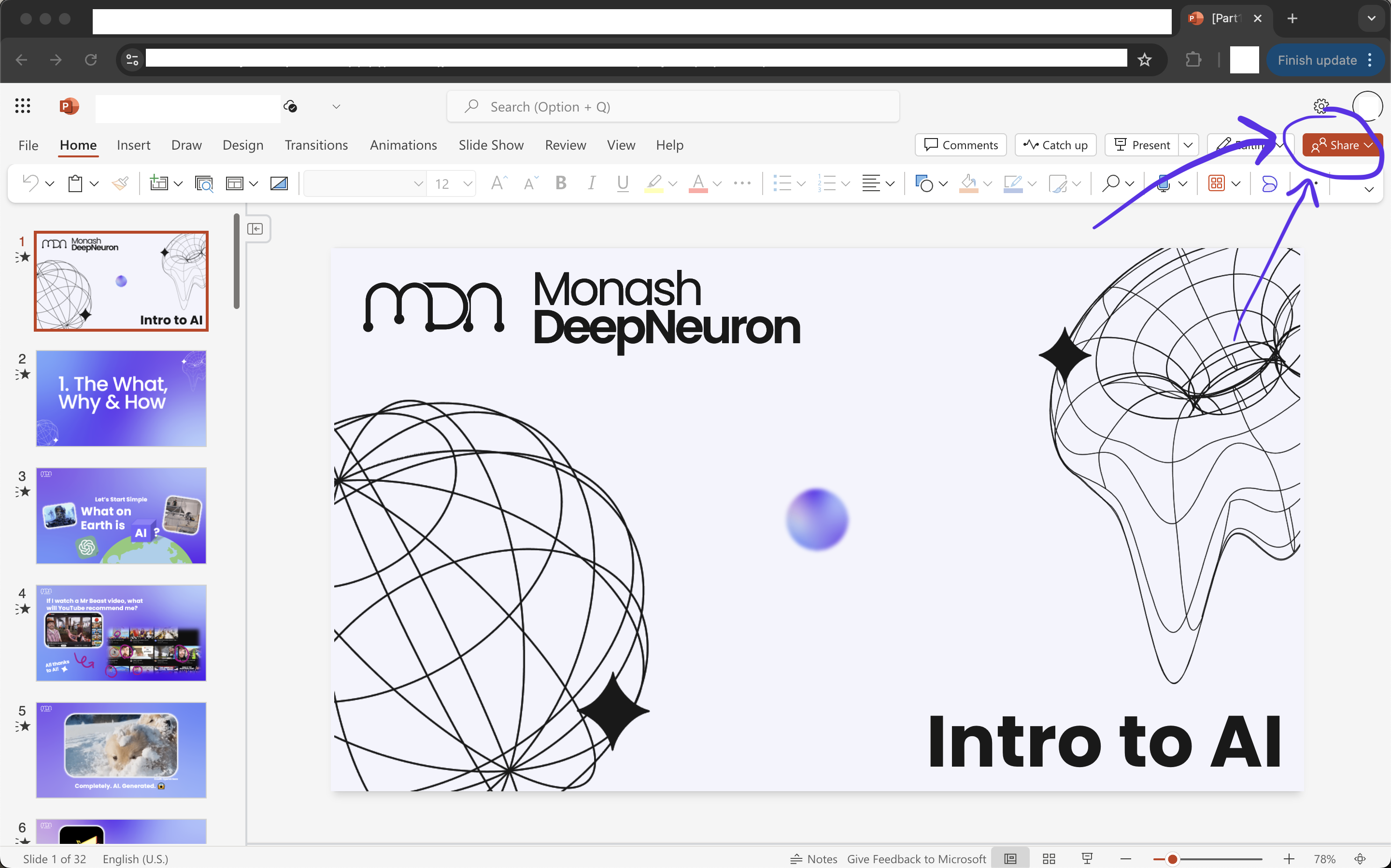
From here, click 'share'
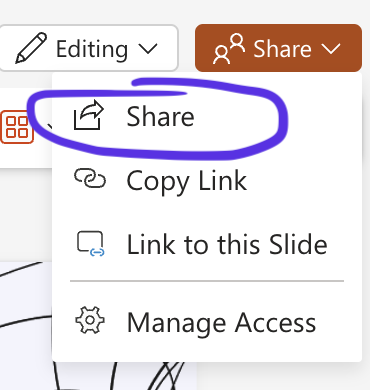
Click the cog wheel icon to the right of 'Copy Link'.
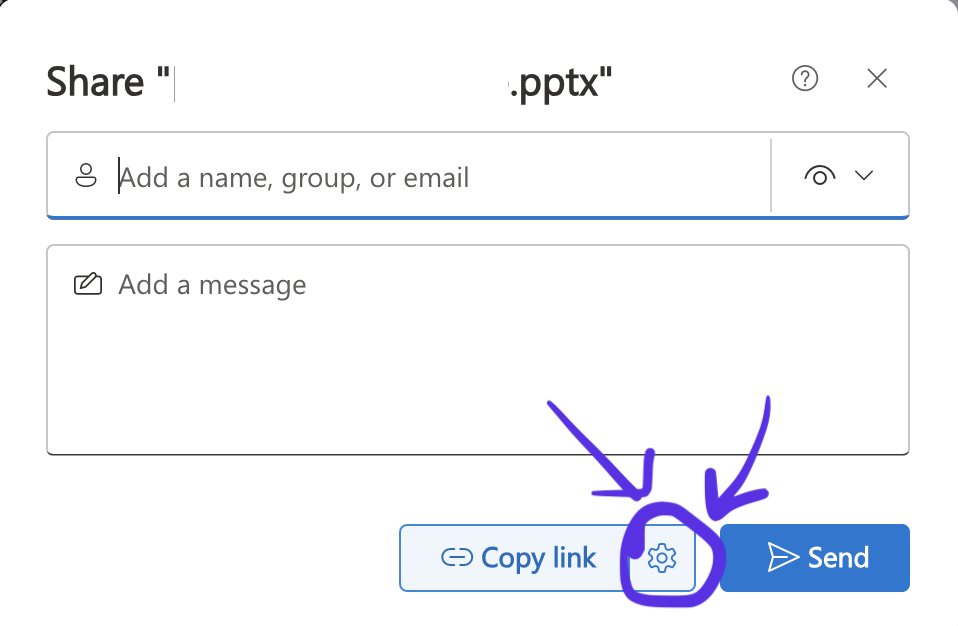
From here, to ensure you share appropriately, check the following things
- Decide who can access the presentation. You can manually enter each person or share with the entirety of Monash University so you don't need to keep adding people as the project scales.
- Decide what powers they can have. You may want them to only be able to edit, view, comment etc.
- Click 'Apply' to activate those decisions for the link.
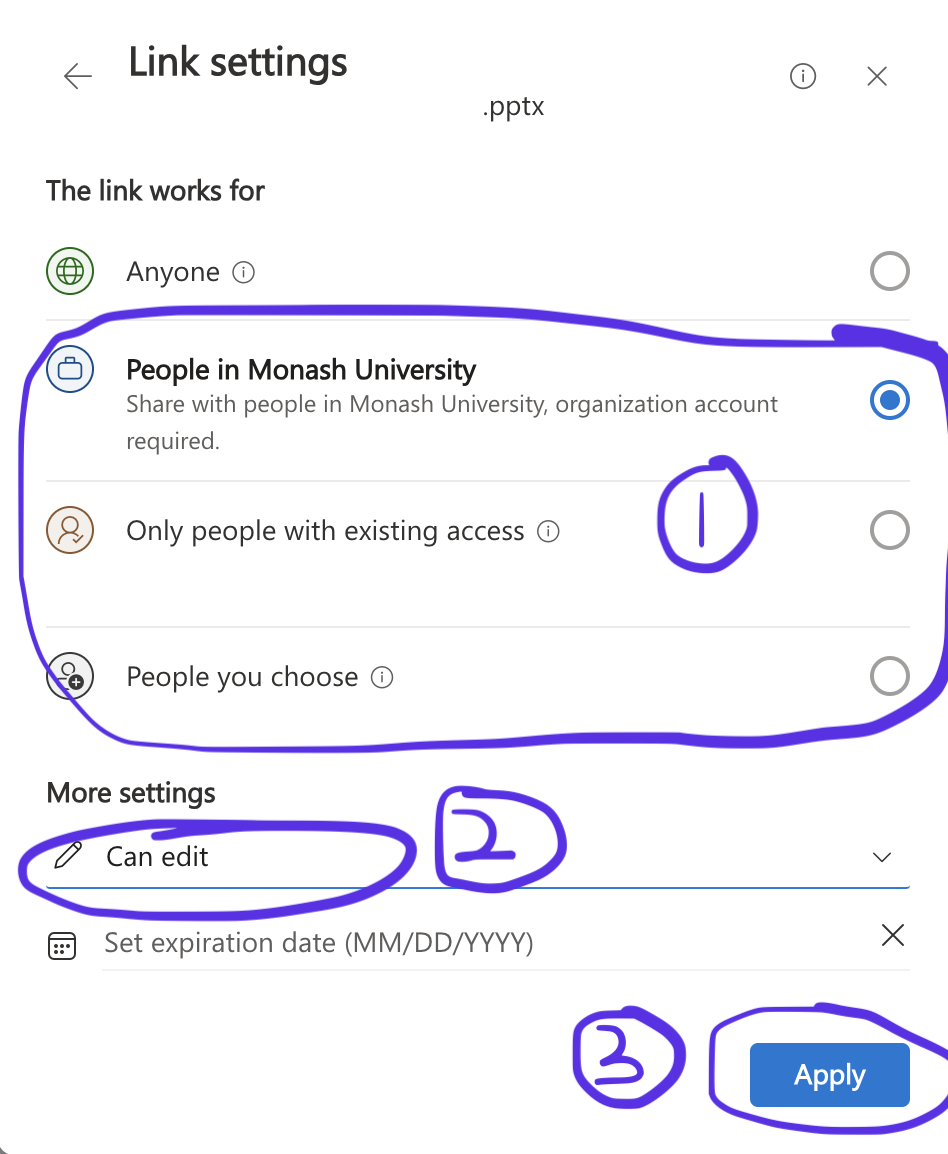
Lastly, with all your changes made, click the 'Copy link' button to share the link to your PowerPoint and send link as needed.
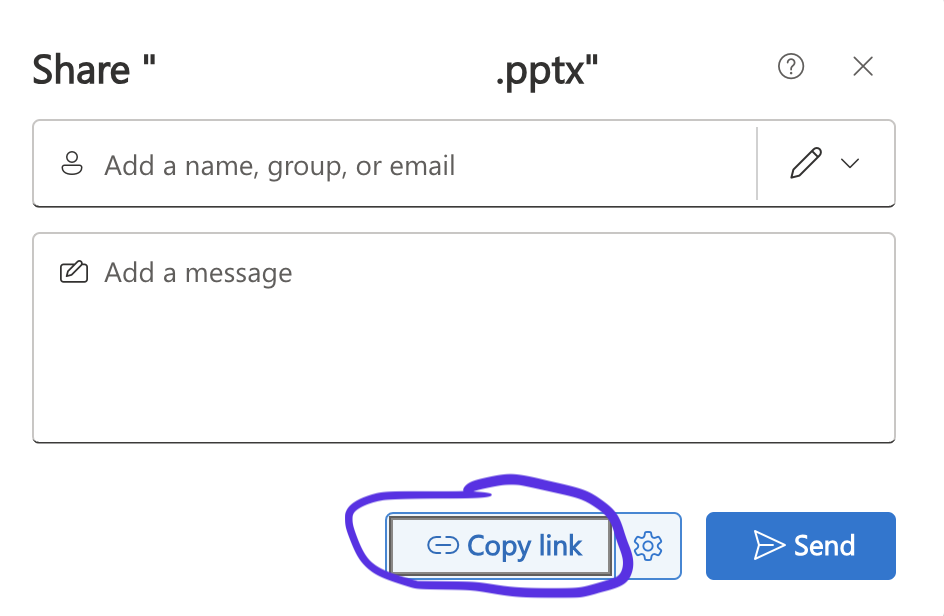
Editing
Since all PowerPoints are shared using OneDrive, when you initially click the link to the PowerPoint, you will be taken to the web app version of the presentation.
**AVOID** making changes on your browser (i.e. web app).
Use PowerPoint desktop app instead
The desktop app is more powerful and robust (less buggy).
Begin by finding the 'Editing' Button on your powerpoint ribbon (usually top right)
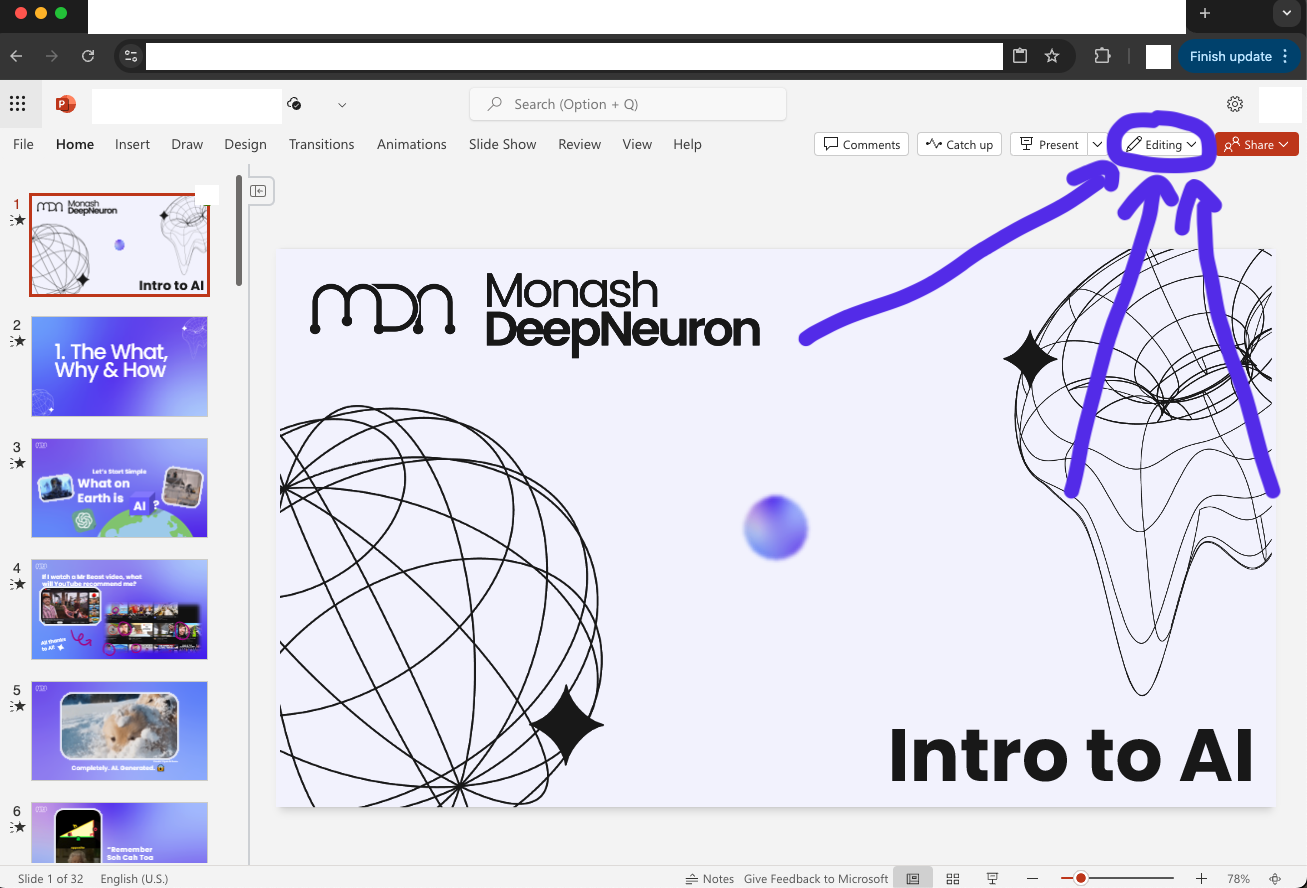
From the dropdown, select 'Open in Desktop'
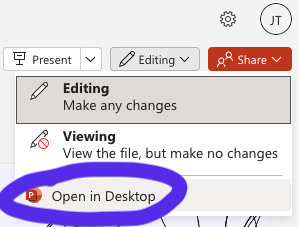
Your browser will then prompt you to open the presentation using your desktop PowerPoint application.
Select 'Open Microsoft Powerpoint.app' or the respective button on your device.
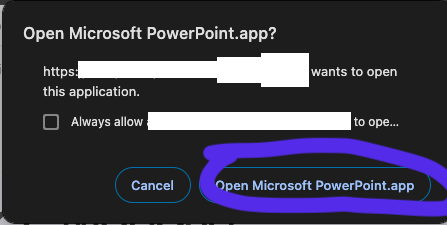
Your device will now open the presentation on the actual PowerPoint desktop application.
Do all your editing here.
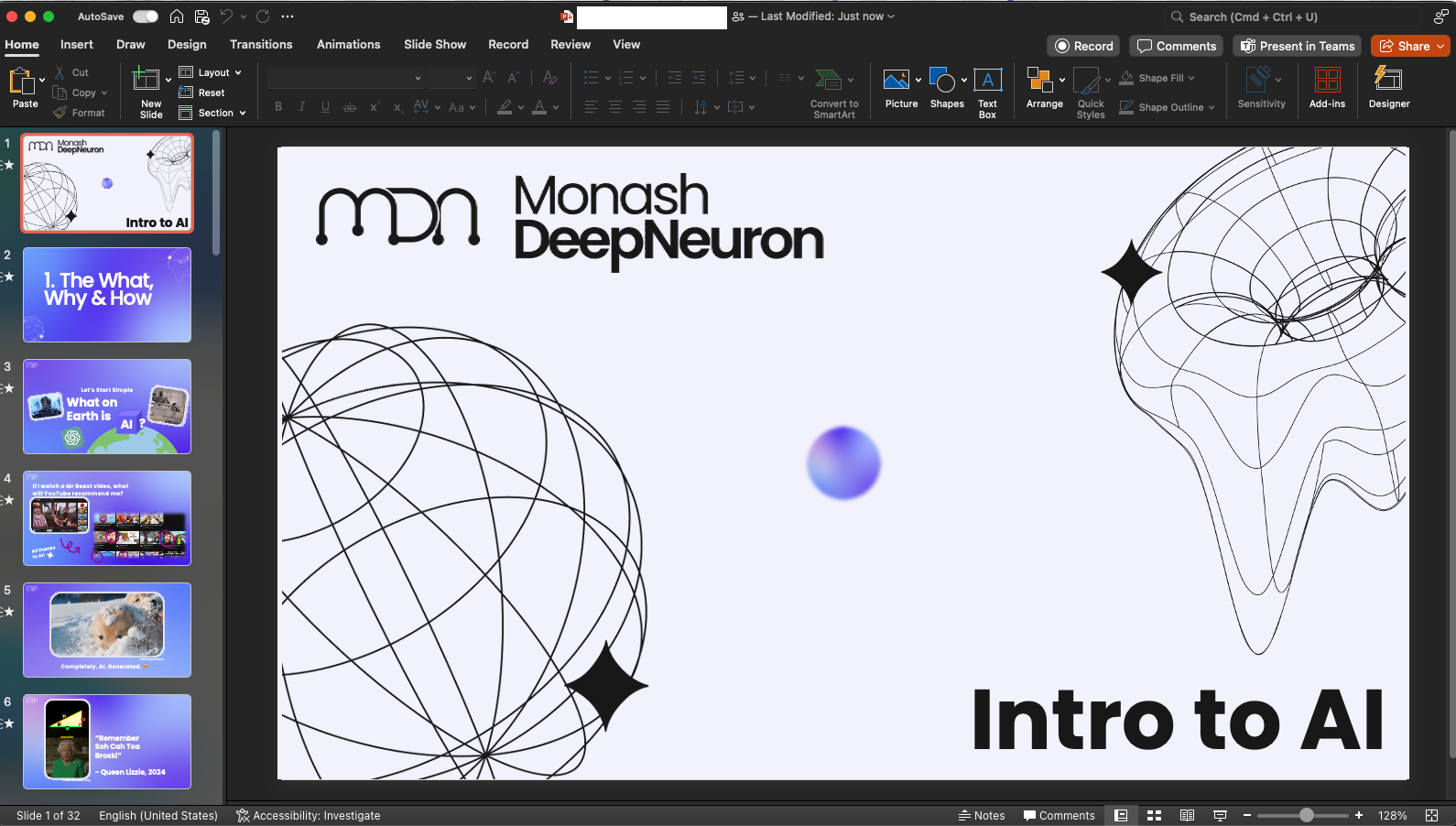
Design Language
The set of visual elements, principles, and rules that define a PowerPoint's look and feel.
It it crucial that all PowerPoints have a consistent design language (unless the nature of the workshop requires otherwise) as this helps us make the presentation more aesthetic.
Fortunately, as an MDN member, there is not much work required from your end since our Marketing team has already made an MDN Brand Guide (Figma)
Click here to use the MDN Brand Guide (GDrive)
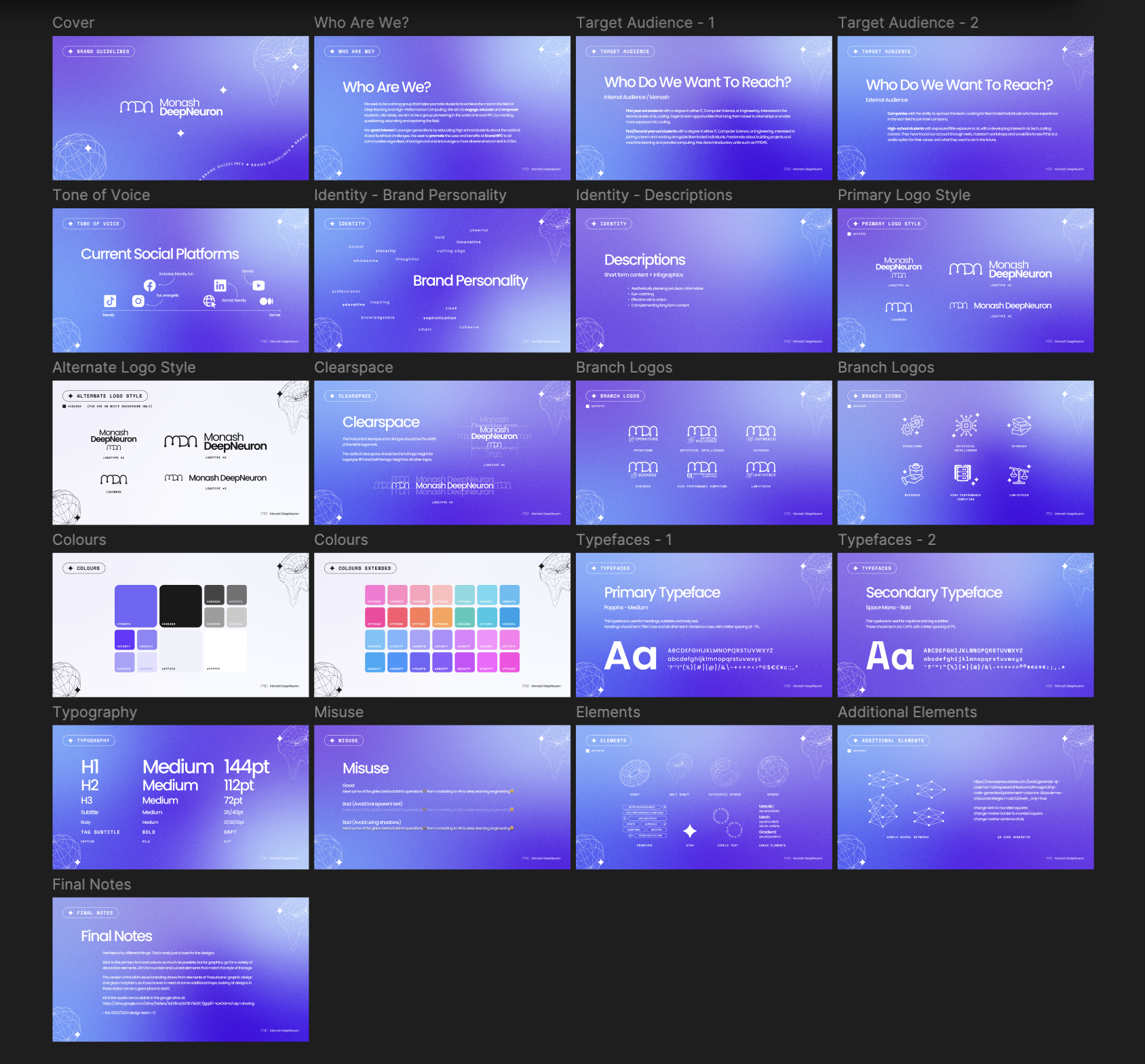
This brand kit is quite comprehensive on MDN's visual identity.
Use the navigation bar to move through the guide.
You are to adhere to this guide as strictly as possible when designing your slides (i.e. copy the logo components, colours, typography etc).
Transitions
Special effects that control how a slide enters and how the previous slide exits.
Think about transitions like the animation/s between slides.
There are multiple transitions available using PowerPoint for your use. Feel free to play around with different options to suit your vision and direction in the workshop/presentation.

Morph
Morph is our most commonly used transition at MDN.

Transition in PowerPoint which looks for assets (images, text etc) that are on consecutive slides (one after the other), and creates a smooth animation for any changes in those assets (different location, rotated etc) when you move from one slide to the other.
This can create a strong sense of flow and make the assets feel as if they're moving through space rather than being standard presentation slides.
This is particularly cool when rotating 3D assets across consecutive slides.
See the tutorial video above to see how this is used.
Animations
Visual effects that can be applied to text, images, shapes, and other elements on a slide.
These help create visual interest.

<span style="color: white; font-weight: bold;">Entrance</span>
For any asset you want to bring into/introduce into the frame.
<span style="color: white; font-weight: bold;">Emphasis</span>
Moves existing assets in the frame.
<span style="color: white; font-weight: bold;">Exit</span>
For any asset you want to remove from the frame.

The animation pane helps you see the order of animations- you can utilise this to be deliberate with order.
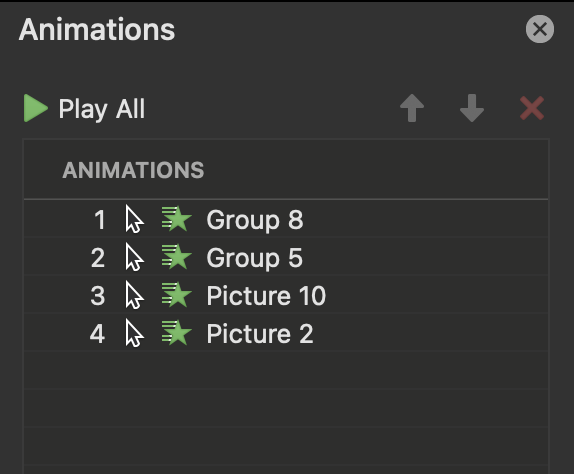
**Be careful** not to distract with your animations- they should enhance the existing content.
Images
The use of images key during your presentation, since visual information is most easily consumed by your audience.
Ensure your images are formatted to maximise their effect.

Within 'Picture Format' you have a plethora of options to manipulate the original image.
See the video tutorial above for what we specifically do at MDN.
Removing background
Within 'Picture Format', select 'Remove Background'

You can then use the pen to keep and remove portions of the image. This may take some time since PowerPoint presumes areas you want to keep/remove.

Formatting
The organisation of assets on a slide/s (text, images, etc).
Text
Avoid massive chunks of text.
Use dot points to summarise big lengths of text.
Spread across slides if needed to reduce text on each individual slide.
Utilise text size, bolding and underlines to emphasize and diminish key points.
Images
Ensure all images on your slides have the same formatting (corners, shadows etc).
Alignment
In pptx, go to View → Gridline

Use this to align all your elements within those gridlines so that all assets look in line and proportionate.
<p align="center">
<figure style="display:inline-block; margin-right: 10px;">
<img src="./images/bad.png" alt="Bad Formatting" />
<figcaption>Bad formatting</figcaption>
</figure>
<figure style="display:inline-block;">
<img src="./images/good.png" alt="Good Formatting" />
<figcaption>Good formatting</figcaption>
</figure>
</p>
3D Assets
3D objects are a unique asset type in pptx, in the same way that text or images are.
They can be rotated just as real 3D objects can be.
You can create your own object or download an existing one.

Existing assets
If you are downloading existing 3D assets and using them in your slides, ensure you credit the asset **[HERE.](https://docs.google.com/spreadsheets/d/1tTHxVz-OatnuEpV0VH1a2r_g0UMTXH5AMPUw_1GM7iY/edit?usp=sharing)**
Here is a template you can use if you don't have an existing one: 3D Model Acknowledgements Template
When downloading, ensure the asset is either:
- .obj
- .glb
You can then import/drag into your pptx and use it as needed.
Watch the video tutorial above for a demonstration.
Acknowledgements
This book is part of Monash DeepNeurons collection of internal training resources. It is built and maintained internally by members of Monash DeepNeuron.